Steven Brust
Books: Fantasy | Science Fiction
Gypsy with Megan Lindholm (1982) , To Reign In Hell (1984), Brokedown Palace (1986), The Sun, the Moon and the Stars (1987), Cowboy Feng's Space Bar and Grille (1990), Freedom and Necessity with Emma Bull (1997)
The Khaavren Romances: The Phoenix Guards (1991), Five Hundred Years After (1994)
The Viscount of Adrilankha: Paths of the Dead (2002), Lord of Castle Black (2003), Sethra Lavode (2004)
Published Order: Jhereg (1983), Yendi (1984), Teckla (1987), Taltos (1988), Phoenix (1990), Athyra (1993), Orca (1996), Dragon (1998), Issola (2001), Dzur (2006), Jhegaala (2008), Iorich (2009), Tiassa (2011), Hawk (2014)
The Desecrator (2011)
Chronological Order: Taltos (1988), Dragon (1998), Yendi (1984), Jhereg (1983), Teckla (1987), Phoenix (1990), Athyra (1993), Orca (1996), Issola (2001), Dzur (2006), Iorich (2009)
Thieves' World: Enemies of Fortune (2004)
Anthologies
The Sandman Book of Dreams (1996), The Essential Bordertown (1998), Year's Best Fantasy 5 (2005)
Steven Brust has written some excellent books, including the Dragaera novels, all of which I have thoroughly enjoyed and highly recommend. I'm in the process of trying to track down the rest of his books which I have yet to read, and waiting impatiently for his new books. The main problem with Steven Brust is that he writes too slowly.
The Vlad Taltos novels, the Khaavren Romances, and The Viscount of Adrilankha are set in Brust's Dragaeran lands, with the Taltos novels being based upon the short life of the assassin Vlad, a human who has been somewhat integrated into Dragaeran society, while the Khaavren Romances, which I loved, are somewhat more "historical" and discuss the middle periods of the Dragaeran empire. Some of the Vlad novels I really like, others were not as good, but bad Brust is still better than much fantasy on the market.
I apologize in advance for any spelling errors. I've checked the page several times in an effort to find all the mistakes, but names that aren't in the spell check dictionary, combined with my poor typing skills tends to lead to mistakes. Please let me know when you find errors.
Although I have compiled character lists for the Dragaera books, these are in no wise complete. They were simply but together for my own edification, and to answer questions about recurring characters, especially characters that occur in different series.
Stand-Alone
To Reign in Hell (1984)
 To be honest, the best description I can give of the book, is the one on the back cover (I have the 2000 Orb reprint):
To be honest, the best description I can give of the book, is the one on the back cover (I have the 2000 Orb reprint):
The time is the Beginning.
The place is Heaven.
The story is the Revolt of the Angels--
a war of magic, corruption and intrigue
that could destroy the universe.
Well, maybe not the destroy the universe bit, since most of us are at least vaguely familiar with the story of the fall of Satan, but the rest of it is about right.
The reason I like this book so well is that--despite knowing the story and how things are going to turn out--I kept hoping that things were going to work out. I really wanted Satan to patch things up with Yaweh, even though I knew he wouldn't.
I also liked it because, as with all Steven Brust's books, it's amusing. Take the very first sentence:
Snow, tenderly caught by eddying breezes, swirled and spun in to and out of bright, lustrous shapes that gleamed against the emerald-blazoned black drape of sky and sparkled there for a moment, hanging, before settling gently to the soft, green-tufted plain with all the sickly sweetness of an over-written sentence.
I promise, the rest of the book isn't written like that. But it does show his sense of humor throughout.
Although the dialog isn't quite as sharp as his later books, it's still good, and the story is fantastic (for both definitions of the word.) If you are not yet a fan of Steven Burst, I would certainly recommend starting with this book. It's a quick read, and to be honest simply wonderful.
Orb Books
- March 2005 | Rating: 8/10
- December 2009 | Rating: 8/10
Freedom & Necessity (1997) with Emma Bull
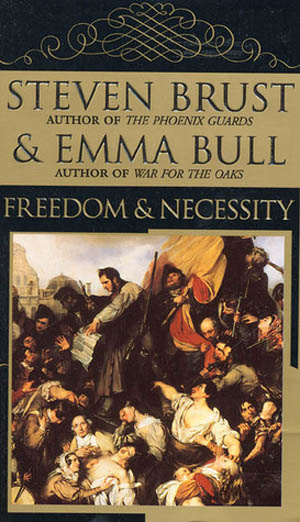 Delving back into Brust section of my bookshelves, I came back with Freedom and Necessity, a book that I remember as complicated, although good. And since I remembered nothing of the plot, I figured it was a good candidate for re-reading.
Delving back into Brust section of my bookshelves, I came back with Freedom and Necessity, a book that I remember as complicated, although good. And since I remembered nothing of the plot, I figured it was a good candidate for re-reading.
I have to admit that as much as I like this novel, reading it makes me feel stupid.
There are tons of historical, political, and philosophical references that, if I were better educated, I am sure would have made the reading even deeper. Unfortunately, my political and philosophical education is sorely lacking, and my knowledge of history is spotty--some times and subjects I'm fairly familiar with, while my others I don't have a clue.
The story, set in late 1849 is written as a compilation of letters, journal entries, and newspaper articles. It's a style that takes some getting used to, but gives a strange sense of authenticity. Though as a regular letter writer, I have to wonder how the characters found the time to write everything down in the detail they did!
Interestingly, the book leads me to wonder about the line between fantasy and other types of fiction, in that there is very little "traditional fantasy" to be found. I have not read any other books by Emma Bull, but the style of this book is strikingly different from other books by Steven Brust I have read. Not to say that he has a specific style--anyone who has read the Khaavren books and the Vlad Taltos books should know better--but there is little familiar in this book to his other books.
This is, as I said, a very good book, but it is not the first Steven Brust book I would recommend to someone--it's too different from his other books for someone to judge whether they liked his style or not. But I do recommend it. Though if you're like me, it may create a desire to learn more about history, philosophy, and political science.
Tor Fantasy
Rating: 7/10
Brokedown Palace (1986)
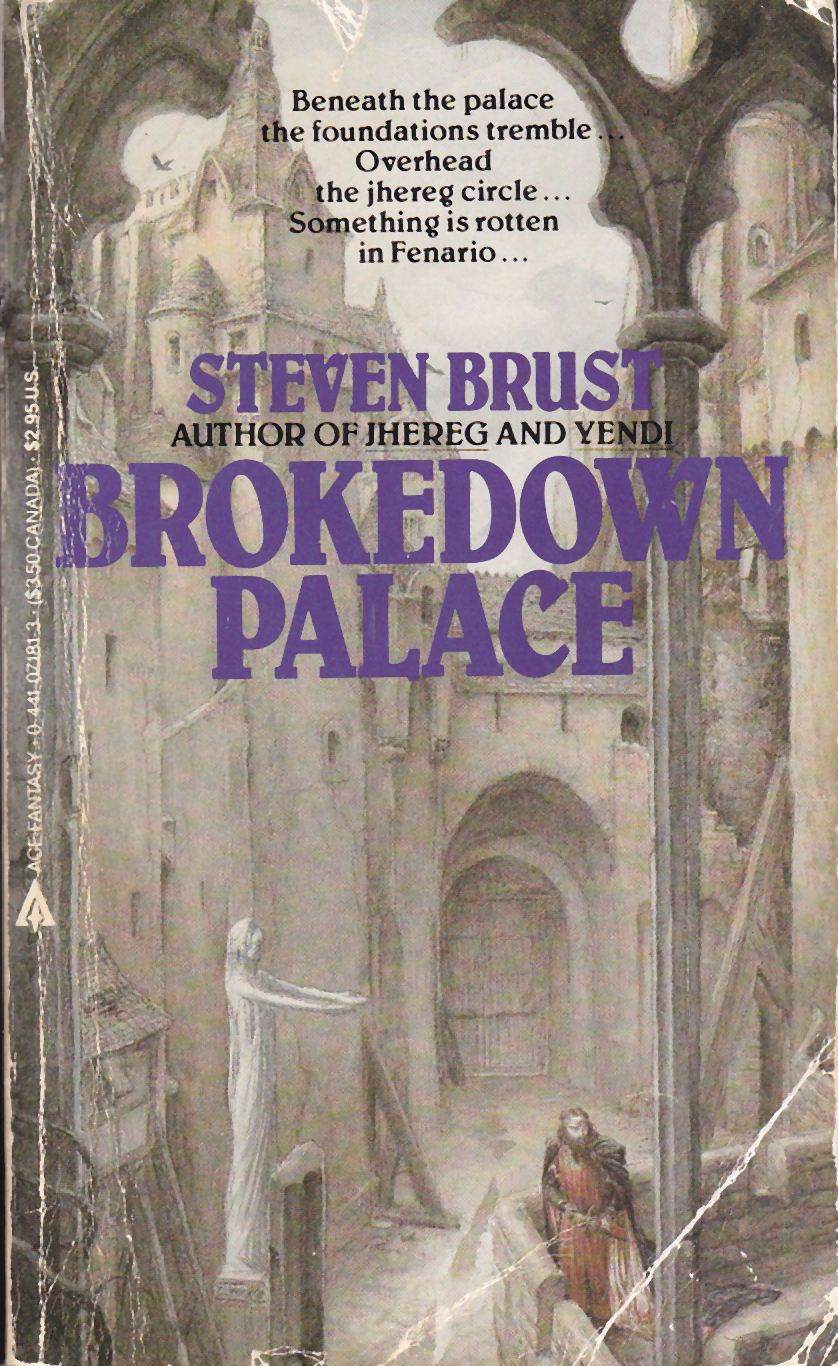 I don't know how long it's been since I read Brokedown Palace, but it was long enough ago that I didn't remember any of the story, and I don't think I'd yet read many of his books other than the first couple Vlad Taltos books. Which meant that there were plenty of pleasant surprise in store for me as I reread this book.
I don't know how long it's been since I read Brokedown Palace, but it was long enough ago that I didn't remember any of the story, and I don't think I'd yet read many of his books other than the first couple Vlad Taltos books. Which meant that there were plenty of pleasant surprise in store for me as I reread this book.
Although set in the same world as the Vlad Taltos books and the Khaavren romances, Brokedown Palace is set not in Dragaera, but in Fenario (the land that Vlad's grandfather came from). Although the only familiar characters I caught were Devera, the Demon Goddess, and Miska the coachman, there are references to other books (or, considering when it was written, books yet to come.) Anyone familiar with The Phoenix Guards should recognize the prologue, although it comes at the tale from a different direction.
I'm not quite certain where this book fits into the time frame. Near as I can tell, it's about a thousand years after The Phoenix Guards, but I'm not sure where that places it precisely in the time line, although my guess is just before Vlad is born. (This is only a guess)
Brokedown Palace reads like a folktale, which is one of the things I really like about it. I particularly love the interludes, which are small stories within the story. (I know that these stories and the title of the book relate to Grateful Dead songs, but I've never liked the Grateful Dead, so all those references are lost on me.)
The story is of four brothers, although told primarily from the point of view of the youngest of the four, Miklos. Although I like Miklos, I find Vilmos the most interesting of the four brothers. Mostly because the other three seem to want to use Vilmos for their own ends, while his wants and needs are simply to care for his norska. (And I have to say, I still can't figure out precisely what norska look like. Are they rabbit like? Yet omnivores requiring meat?)
The oldest and youngest brothers are at odds, while the middle two brothers are to some degree, caught between their feuds, the point of contention is the palace--the brokedown palace that is falling apart around them.
The downside of this book? Good luck finding a copy. I lfound mine used years ago, but haven't ever seen it again since.
If you have not read any Steven Brust, Brokedown Palace would make an excellent introduction. If you have read the Vlad and Khaavren novels, then you'll enjoy this book for the vague references to things Dragaeran, and the way Dragaera is called Faerie, the way Vlad's grandfather refers to it.
March 2006 | Rating: 9/10
The Phoenix Guards (1991)
 As is typically the case, once I finished reading the Vlad Taltos books, I felt myself consumed by an overwhelming desire to go back and re-read the other Dragaeran books. That is to say, mention of characters and events in the Vlad Taltos books whetted my appetite for re-reading about events of The Phoenix Guards and the following books.
As is typically the case, once I finished reading the Vlad Taltos books, I felt myself consumed by an overwhelming desire to go back and re-read the other Dragaeran books. That is to say, mention of characters and events in the Vlad Taltos books whetted my appetite for re-reading about events of The Phoenix Guards and the following books.
Of course these books might not be written for everyone, but they are for people who enjoy reading for the sake of reading. As the author notes say:
Paarfi:...I do not mean that I write for those who simply like a good tale, well told, or for those who use the novel in order to explore what critics are pleased to call "the human condition," or for those who treat the story as a distraction from the cares of the day, but rather, I write for those who take joy in seeing words well-placed upon the page.
Brust: Typesetters?
These books read as if he had an awful lot of fun writing them.
hich is good, because I had an awful lot of fun reading The Phoenix Guards.
It would seem, therefore, that if we were to allow our readers, by virtue of being in the company of the historian, to eavesdrop on this interchange, we will have, in one scene, discharged two obligations; a sacrifice, if we may say so, to the god Brevity, whom all historians, indeed, all who work with the written word, ought to worship. We cannot say too little on this subject.
The writing is completely over-the-top, which is part of it's charm and joy. But if you aren't in the mood for it–forget it.
But if you are in the mood, then it is wonderful.
The Serioli, who departed the area to avoid any of the unfortunate incidents that war can produce, left only the name for the place, which was “Ben,” meaning “ford” in their language. The Easterners called the place “Ben Ford,” or, in the Eastern tongue, “Ben gazlo.”
After ten years of fierce battle, the Imperial Army won a great victory on the spot, driving the Easterners well back into the mountains. The Dragonlords who had found the place, then, began calling it “Bengazlo Ford.” The Dragons, wishing to waste as little time on speech as possible, shortened this to Benglo Ford, or, in the tongue of the Dragon, which was still in use at the time, “Benglo ara.” Eventually, over the course of the millennia, the tongue of the Dragon fell out of use, and the North-western language gained preeminence, which rendered the location Bengloara Ford, which was eventually shortened to Bengloarafurd. The river crossing became the Bengloarafurd Ford, which name it held until after the Interregnum when the river was dredged and the Bengloarafurd Bridge was built.
I mean, that is just utterly delightful. And there are many bits that are simply true. Take this bit on distance:
It is true, for example, that the distance from the Gate of the Darr to Ripple Point is scarcely a league, while it is a good thirty leagues from the Gate of Iron to Fosson's Well, yet, because the latter is over level ground with a good road laid on it, while the former is nearly straight up a mountainside covered in loose and crumbling rock, we may in justice assert that each of these places lies the same distance from the heart of Dragaera City, that distance being about thirty hours, or a full day and a night.
Driving in WV is much like that–I consider distances in time, since 10 miles of narrow, hilly, gravel road is approximately the same as 60 miles of interstate.
Khaavren, a young Tiassa from an impoverished house, has decided that with the changing of the cycle, joining the Phoenix Guards is a good way to distinguish himself and make his name. He meets Tazendra and Aerich who see this as a good plan and join him on his trip to the capital where they meet Pel, and new member of the guard, and the four become fast friends.
I love the characters. Khaavren the Tiassa, Tazendra the Dzurlord, Aerich the Lyron, and Pel the Yendi seem as real to me when I read these books as any people I see. And the dialog--I love the dialog.
Consider passages like this:
Tazendra, who had been watching the one called Uttrik as he removed his doublet, drew his sword, and began taking practice thrusts with it, said, "Good Khaavren."
"Well?"
"I do not think this gentleman will give you much sport."
"You think not?"
"Well, you perceive how, in practicing, he strikes only at the air."
"That is not unusual, when preparing for a contest."
"No, and yet he seems to miss with every third stroke."
How can you read that and not smile, or even laugh to yourself? Which is, of course, the reason I can read this book over and over again. Because it makes me laugh while I enjoy a marvelous story.
Yes, the book is full of long descriptions and details. But those details are fun. Consider the passage on Bengloarafurd, which I won't relate here and thus spoil the fun for you, but although you realize where he's going with it almost immediately, it's still funny, since it's real.
It's also interesting to read about characters who are going to cause the Interregnum, as well as the destruction of Dragaera City. If you've read the Vlad Taltos books, you know about Aliera e'Kieron, but you know nothing about Adron e'Kieron. What kind of man could wreak such havoc, and what reasons could he possibly have had for doing so?
Through Khaavren we come to know Adron, but that's not the reason to read this book. The reason to read this book is the adventures that Khaavren and Tazendra and Aerich and Pel have.
I do have a small complaint about the cover, which is, who is that supposed to be ON the cover? Khaavren is described as having long, curly hair, and wearing the pale blue and white of the house of Tiassa, Aerich always wears copper or brass vambraces, it's not Tazendra for obvious reasons, and although at the start of the book Pel's eyes are described as blue, and at the end they are described as black, it doesn't really look like Pel either. And whoever this man is, he's not wearing the gold cloak of the Phoenix Guard. So although it's an interesting cover, it doesn't seem to portray any of the characters.
If you are not familiar with Dragaera through the Vlad Taltos books, this would be a perfect introduction. If you have read the Vlad books, you'll get to spend more time in a place you have probably come to love, and learn about the Empire before the Interregnum, which is a far different place than the Empire inhabited by Vlad and Morrolan.
The only bad thing is that you'll spend days trying to get Paarfi's writing style out of your head.
If you haven't read Phoenix Guards, then I highly encourage you to do so, and envy you the experience of reading this book for the first time.
Published by Orb
- February 2005 | Rating: 10/10
- February 2006 | Rating: 10/10
- June 2007 |
- March 2017 | Rating: 9.5/10
Characters: Khaavren of Castlerock, Aerich, Pel, Tazendra, G'aereth, Illista, Allistar, Uttrik e'Lanya, Jenicor e'Tericks, Lyrta e'Tenith, Gyorg Lavode, Lanmarera, Count Shaltre, Lady Seodra, Lord Garland, Adron e'Kieron, Kathana e'Marish'Chala, Srahi, Mica, Crionofenarr, Rollondar e'Drien, Emperor Tortaalik, Consort Noima
Five Hundred Years After (1994)
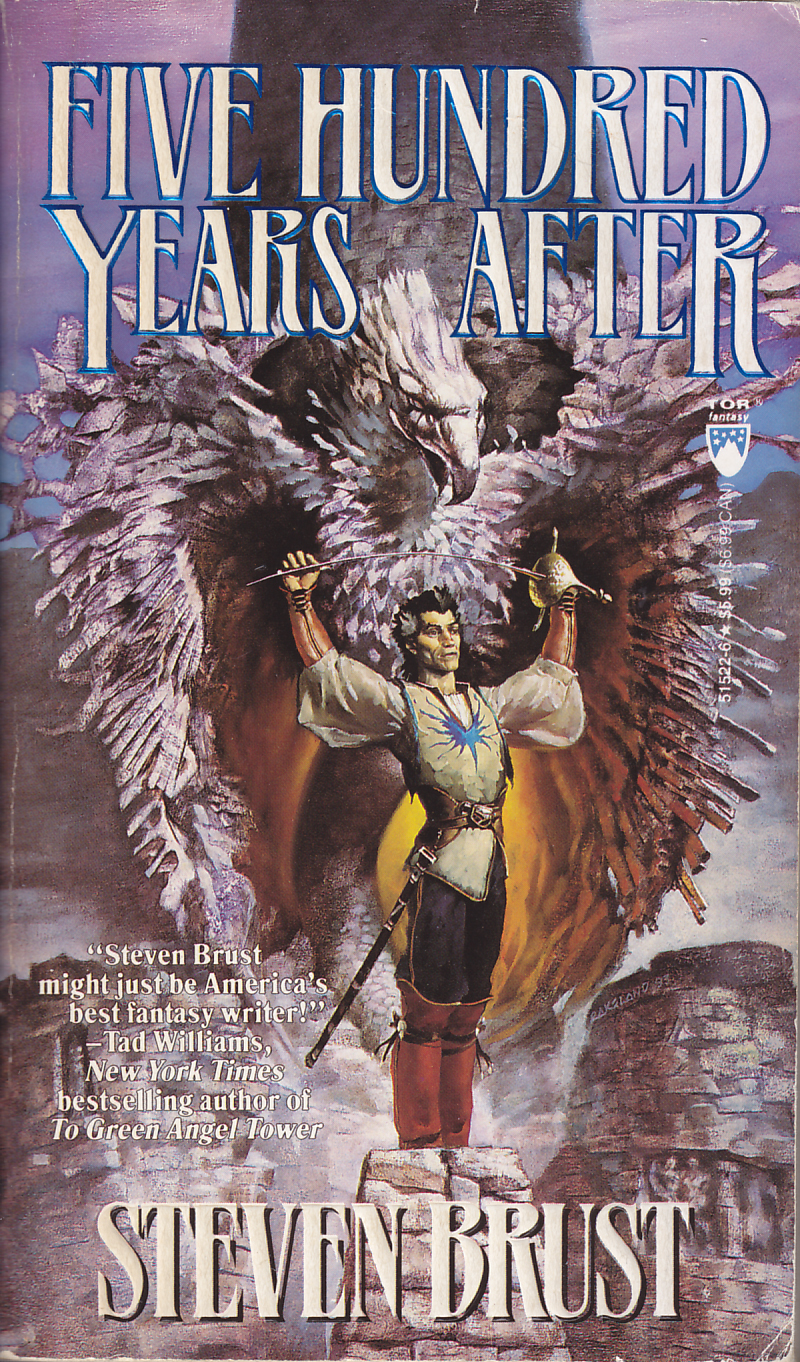 If you have read the Vlad Taltos books, then you already know the outcome of Five Hundred Years After: Adron's disaster, which lead to the Interregnum. But what we don't know, is the story that leads up to Adron's disaster. Why did Adron act in the manner he did? What was the involvement of those who called Adron friend. What about the Enchantress of Dzur Mountain, Sethra Lavode?
If you have read the Vlad Taltos books, then you already know the outcome of Five Hundred Years After: Adron's disaster, which lead to the Interregnum. But what we don't know, is the story that leads up to Adron's disaster. Why did Adron act in the manner he did? What was the involvement of those who called Adron friend. What about the Enchantress of Dzur Mountain, Sethra Lavode?
All of these questions, and more, does this book answer, as well as the question of, what happens to those for who we have come to have interest, even feelings, and by this I mean Khaavren and Aerich and Tazendra and Pel.
At the start of Five Hundred Years After, our friends have drifted apart. Khaavren has given the past five hundred years to the Phoenix Guards, Pel has studied the Art of Discretion, and Aerich and Tazendra have retired to their estates, Tazendra to further study wizardry. However, several assassinations and an assassination attempt draw the four back together, as the Empire becomes more and more chaotic at the approach of the Meeting of Principalities to determine the Emperor's Allowance.
But does that really tell you about the book? Not really. For again, like The Phoenix Guards, the delight in this book is in the storytelling and the dialog.
I have to admit that Tazendra may be one of my favorite characters. Beautiful and honorable. Not too quick with her thoughts necessarily, but more than quick enough with her sword. I find it fascinating that the big dumb persona of someone who thinks with the sword first is given to a female character. For some reason that gives an entirely different feeling to the character that might be expected.
I particularly like the scene between Tazendra and Sethra Lavode, where they enter the room of Gyorg Lavode. I am always touched by the way that Tazendra learns about Gyorg through viewing his room. And then there is the discussion of the very nature of the Dzur they have.
Sometimes...those of the other houses laugh, or call the Dzur foolish, stupid, or blind, and there is no good answer to such charges, for to kill for such an insult is often beneath the Dzurlord; yet there is always the sword, whose sharpening breathes of the future, and the glory which is not only in being remembered, but in knowing that one has defied the entire world, and pitted one's self against the impossible, and proven, to all who are not Dzur, that there is a value and glory in battle, regardless of the outcome.
I very much like that, because I think it gives back something to Tazendra that perhaps Brust has taken away, with his constant poking fun at her for not being as bright as her friends.
As far as the other characters, I appreciate the way that Khaavren has matured, while still remaining himself. Aerich, far more than Pel, remains a cipher to me. He is so calm and so honorable that I've always had a hard time quite putting my finger on precisely what he is. It doesn't mean I dislike him--indeed I like Aerich very much. Especially now that I know precisely how vambraces work. But he is the hardest for me to pin down.
As far as Adron, I think that Steven Brust does a good job of actually explaining why Adron acted they way he did, and more importantly, how many different random events came together to cause Adron's disaster far more than any feelings or plans on Adron's part. I also appreciate Paarfi's final synopsis of his character.
And the bit about Mario amuses me. Not that it is particularly amusing, but that knowing what one knows at the end of this book, shines a whole new light on the Jhereg take of Mario in Vlad's time.
Because of the disaster that we know occurs at the end of the book, and the limits that placed upon what could happen within the story, the story didn't flow as well for me as the previous book. It was good, and it worked, but once or twice I was distracted, for whatever reason. It's still an excellent book. But it doesn't hold the same place in my heart that The Phoenix Guards does.
If you have read The Phoenix Guards and the Vlad Taltos books, then you absolutely must read Five Hundred Years After, as it ties together so many pieces of history that are dropped throughout Steven Brust's books. But if you have not yet read any Dragaeran books, I would suggest starting instead with The Phoenix Guards. I am quite sure that the book can be read and enjoyed without knowing the background from the other books, but knowing that background just makes it that much better.
I also must add that I owe an apology to Steven Brust. As much as I love The Khaavren Romances and The Viscount of Adralinkha, I always thought that the language was completely over the top. That didn't detract from my enjoyment of the books, but it did amused me to see such convoluted sentences. Thus imagine my surprise upon reading Joseph J. Ellis's Founding Brothers. In the letters quoted that detail the feud between Aaron Burr and Alexander Hamilton I found:
(H)aving Considered it attentively, I regret to find in it nothing of that sincerity and delicacy which you profess to Value...I relied with unsuspecting faith that from the frankness of a Soldier and the Candor of a gentleman I might expect an ingenuous declaration.
--Aaron Burr
and
The length to which this correspondence has extended only tending to prove that the satisfactory redress...cannot be obtained...he deems it useless to offer any proposition except the simple Message which I shall now have the honor to deliver.
--William Van Ness
And Steven Burst doesn't even randomly capitalize words for emphasis.
- February 2005 | Rating: 9/10
- February 2006 | Rating: 9/10
- June 2007 |
Characters: Lord Khaavren of Castlerock Captain of the Phoenix Guard, Aerich Duke of Arylle, Pel/Duke of Galstan, Tazendra Baroness of Daavya, Srahi, Mica, Fawnd, Sethra Lavode Enchantress of Dzur Mountain, Lord Adron e'Kieron Duke of Eastmanswatch, Lady Aliera, Lord Rollondar e'Drien the Warlord, Molric e'Drien, Emperor Tortaalik, Consort Noima, Prime Minister Jurabin, Graycat, Grita, Mario, Laral, Dunaan, Chaler, Princess Sennya Duchess of Blackbirdriver
The Viscount of Adrilankha is one book in three volumes, or perhaps six books in three volumes, depending upon how you want to look at it. Unlike other Steven Brust books, each book is not a self-contained story, and so the resolution at the end of each book is not all that I would have desired. For obvious reasons, this bothered me more when I was reading the series, and waiting impatiently for the third book to be published, than it does now, as I go back to re-read the series, with all three books at hand.
For fans of the Vlad series, the books are also interspersed with stories we have heard mention of in passing, or things we may have wondered about, such as how Morrolan came to possess Blackwand, how the constant party at Castle Black began, what Morrolan and Sethra's first meeting was like, and so on and so forth.
Paths of the Dead (2002)
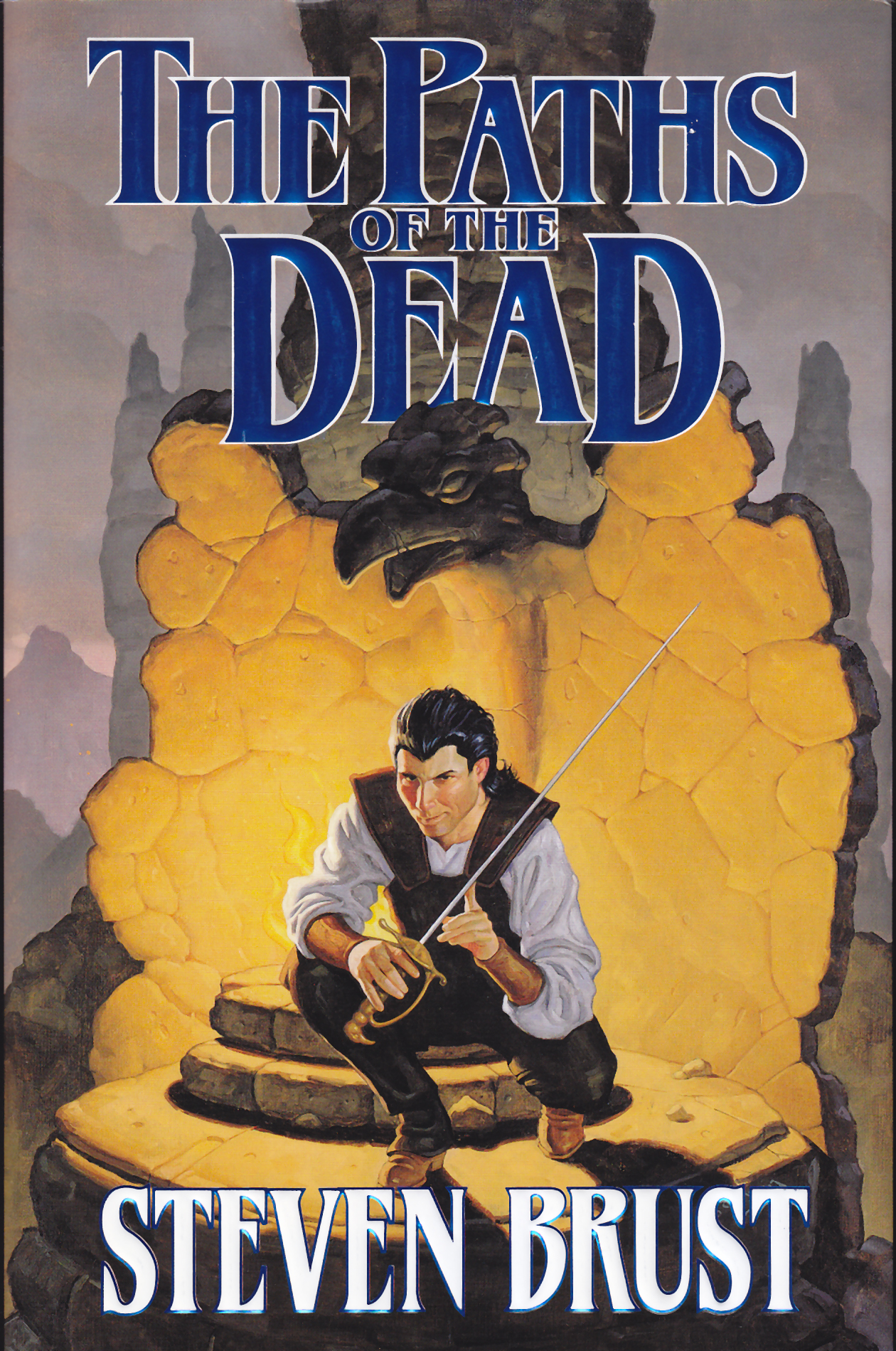 For me, Steven Brust books are like potato chips; I can't read just one.
For me, Steven Brust books are like potato chips; I can't read just one.
And so, having recently finished all the Vlad Taltos book, The Phoenix Guards, and Five Hundred Years After, there was nothing to do but read The Viscount of Adrilankha.
The Paths of the Dead starts 156 years after Adron's Disaster, and the events of Five Hundred Years After. It is still the Interregnum. Sorcery either does not work, or is strongly limited, travel is dangerous, and various lords are attempting to consolidate power and reform the Empire with themselves at the helm.
It also follows the histories of several individuals, some of whom we already have the pleasure of knowing. We meet Morrolan as a youth, and witness the events to which we have read allusions in the various Vlad Taltos books. We meet Zerika, whom we have met in passing in other books, but here we learn of how she regained the Orb. And we have some small dealings with our friends from previous books: Khaavren, Tazendra, Aerich, and Pel; however, we spend more time with the son of Khaavren and Daro: Piro, the Viscount of Adrilankha for whom the series is named.
Plus Sethra Lavode. And The Necromancer. And various Gods.
The main focus, however, switches between Morrolan, Piro, and towards the end, Zerika. We spend some time with the other characters, but the focus is primarily upon Morrolan and Piro.
I have to admit that as much as I like Khaavren, I prefer Morrolan to Piro. And I also prefer to read about Tazendra. Not that there's anything wrong with Piro, I just don't care about him quite as much as I do his father, his father's friends, and Morrolan. This could, however, just be a quirk on my part.
The style in Paths of the Dead is that of the Khaavren Romances, the over the top style of Paarfi of Roundwood, historian and romantic. Although the writing style is far different from the Vlad books, and the dialog is commensurately changed as well, I still have a strong sense of Morrolan in his speech, even if it reads quite differently than his speech in the Vlad books. So kudos to Steven Brust, that he can completely switch styles of writing and still keep the sense of Morrolan that I love so much.
Consider the following:
"It has come to my thoughts that if we should continue warning their victims of impending raids, (the raiders) may take it ill."
"That is possible, my lord. As I consider it, I think it is very possible."
"So I had thought."
"Do you thin, well--do you think we ought to stop giving these warnings?"
"Oh no!" said Morrolan. "I certainly would suggest nothing as drastic as that!"
That passage (and the bit that follows) amuses me to no end.
Another positive is that I really like the cover of this book. Despite the fact that the man on the cover doesn't at all like I imagine Piro to look, I still find the whole thing fascinating, and love looking at it. There's something about the way he's crouching down, holding his sword, and looking straight at you, that seems to be perfect.
If you have not yet read any of Steven Brust's Dragaera novels, this is an excellent place to start. Although you might not take the same joy out of coming across favorite characters that long time readers have, you will have a pleasure denied to us, which is not knowing how things will turn out in the end, and getting to be surprised at the turn of events.
Oh, the introduction is written by Emma Bull and the epilogue is written by Teresa Nielsen Hayden of Making Light.
- 2004 |
- February 2006 | Rating: 8/10
Characters
Morrolan e'Drien, Arra, Lady Teldra, Sethra Lavode, Sethra the Younger, Sorceress in Green, The Necromancer, Khaavren of Castlerock, Daro Countess of Whitecrest, Piro Viscount of Adrilankha, Zivra/Zerika, Lewchin, Shant, Princess Sennya Duchess of Blackbirdriver, Ibronka, Roaana, Kytraan e'Lanya, Tazendra Lavode Baroness of Daavya, Pel/Galstan, Aerich Duke of Arylle, Mica, Tukko, Lar, Clari, Wadre, Mora, Orlaan, Verra, Barlan, Ordwynac, Miska the Coachman, the warlock, Lord Fentor, Marchioness Habil, Count Skinter e'Terics/Duke Kana
Lord of Castle Black (2003)
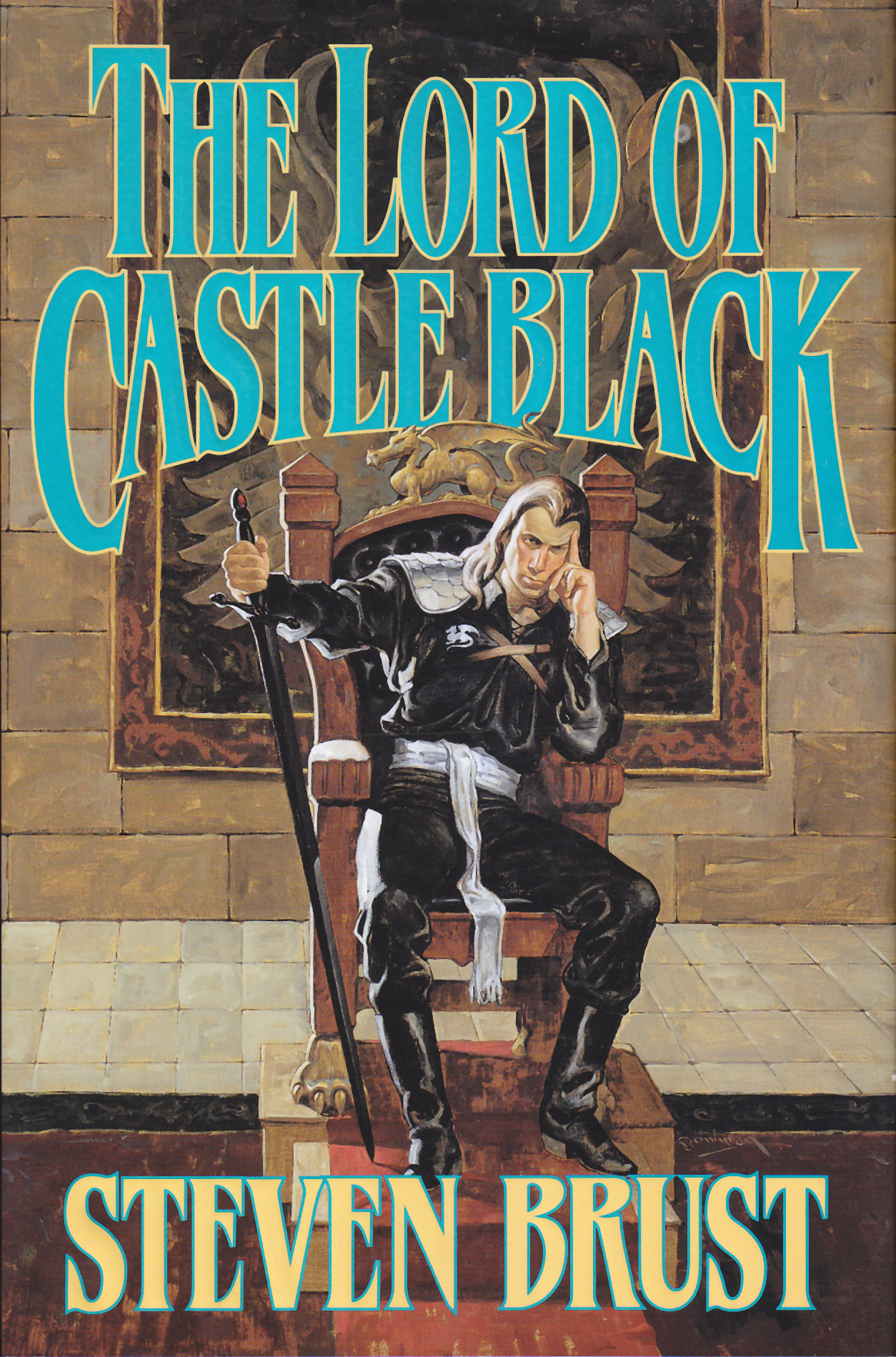 The second volume in the Viscount of Adrilankha series takes up where the first left off, even going back a bit to cover events that occurred towards the end of Paths of the Dead.
The second volume in the Viscount of Adrilankha series takes up where the first left off, even going back a bit to cover events that occurred towards the end of Paths of the Dead.
Zerika is now Empress in name, but has yet to become Empress in fact, and to do so must defeat the forces of Lord Kana, the Dragonlord who had, during the Interregnum, declared himself Emperor, and had no interest in renouncing that claim now that Zerika had returned with the Orb. Additional, Grita has allied herself with Kana in order to extract her revenge upon her enemies.
Although I am not normally a fan of introductions, which usually do little more than summarize the events of the previous book, so that readers can (for some unknown reason) start at book two, skipping book one, because this is Steven Burst, I read the introduction. And was not disappointed, as it almost immediately made me laugh out loud.
We have been informed by those to whom we have entrusted our manuscript for publication that it would be appropriate to explain to the reader some of the events of the story we have the honor to relate...(W)e believe that were there any events in the previous volume of such a nature that they could be omitted without severe damage to the narrative, we should have omitted them to begin with.
And so the introduction goes, so even though I had just read the first book, I made sure not to skip the introduction, because it did far more than summarize the book I had just completed.
As for The Lord of Castle Black, I thoroughly enjoyed seeing Morrolan come into his power.
And above all of this, Morrolan was aware that, more than ever before, he would very much like to find something to kill. By preference, many things, all of them eager to fight back.
If that doesn't just describe a Dragonlord, I don't know what does.
And for fans of the Vlad books, this book describes Morrolan's first meeting with Sethra Lavode, and answers the question of whether he demanded tribute from here.
And of course there was the marvelous storytelling. Although anyone who has read the Vlad Taltos books knows quite well how things are going to end up, still I was drawn into the story, and even on a re-reading, unable to easily put down the book. Partially because I find it so easy to become immersed into these books, and partially for the joy of rereading paragraphs like these:
In only a few minutes, thanks to the training through which Fentor had put them, the companies and battalions were arranged across the field. Upon learning that all was ready, Morrolan, who had not yet learned the importance of ceremony, grandiloquence, and inspirational utterances in convincing the desperate to do the impossible, gave the order to advance, and himself led the way. (It should be added that none of the events which followed did anything to show Morrolan why he ought to use brave words to inspire his army, and so, as far as this historian can determine, he has never learned.)
There is also something about the way that Steven Brust writes that even I, who almost never see images in my head as I read, am able to vividly picture the scene he is describing. No small feat that.
I do, however, have to take some umbrage with the cover of this book. Why on earth does Morrolan look like John Travolta?
Additionally, I am still bothered by the actions of Piro at the end of this book. Zerika is a childhood friend for whom he still seems to have some affection. Although not directly affecting her, his actions seem to go against that friendship, and that bothers me a good deal. Enough that this single issue drops my rating for this book from a nine to an eight--probably because it occurs at the very end of the book, and is one of the last things I read. Teenagers may be rash, but they are also loyal.
Although this is not a good place to start reading Steven Brust this is an excellent second book, and I love learning more about Morrolan and Sethra.
And the Afterword is written by Neil Gaiman.
- 2004 |
- February 2006 | Rating: 8/10
Characters
Morrolan e'Drien Lord of Southmoor, Arra, Lady Teldra, Sethra Lavode, Sethra the Younger, Sorceress in Green, The Necromancer, Khaavren of Castlerock, Daro Countess of Whitecrest, Piro Viscount of Adrilankha, Zivra/Zerika, Ibronka, Roaana, Kytraan e'Lanya, Tazendra Lavode Baroness of Daavya, Pel/Galstan, Aerich, Duke of Arylle, Mica, Tukko, Lar, Clari, Wadre, Mora, Orlaan/Grita, Verra, The Warlock/Viscount of Brimford, Lord Fentor, Marchioness Habil, Count Skinter e'Terics/Duke Kana, Izak, Tonchin, Brawre, Tsanaali, Illista, Baron Loraan
Sethra Lavode (2004)
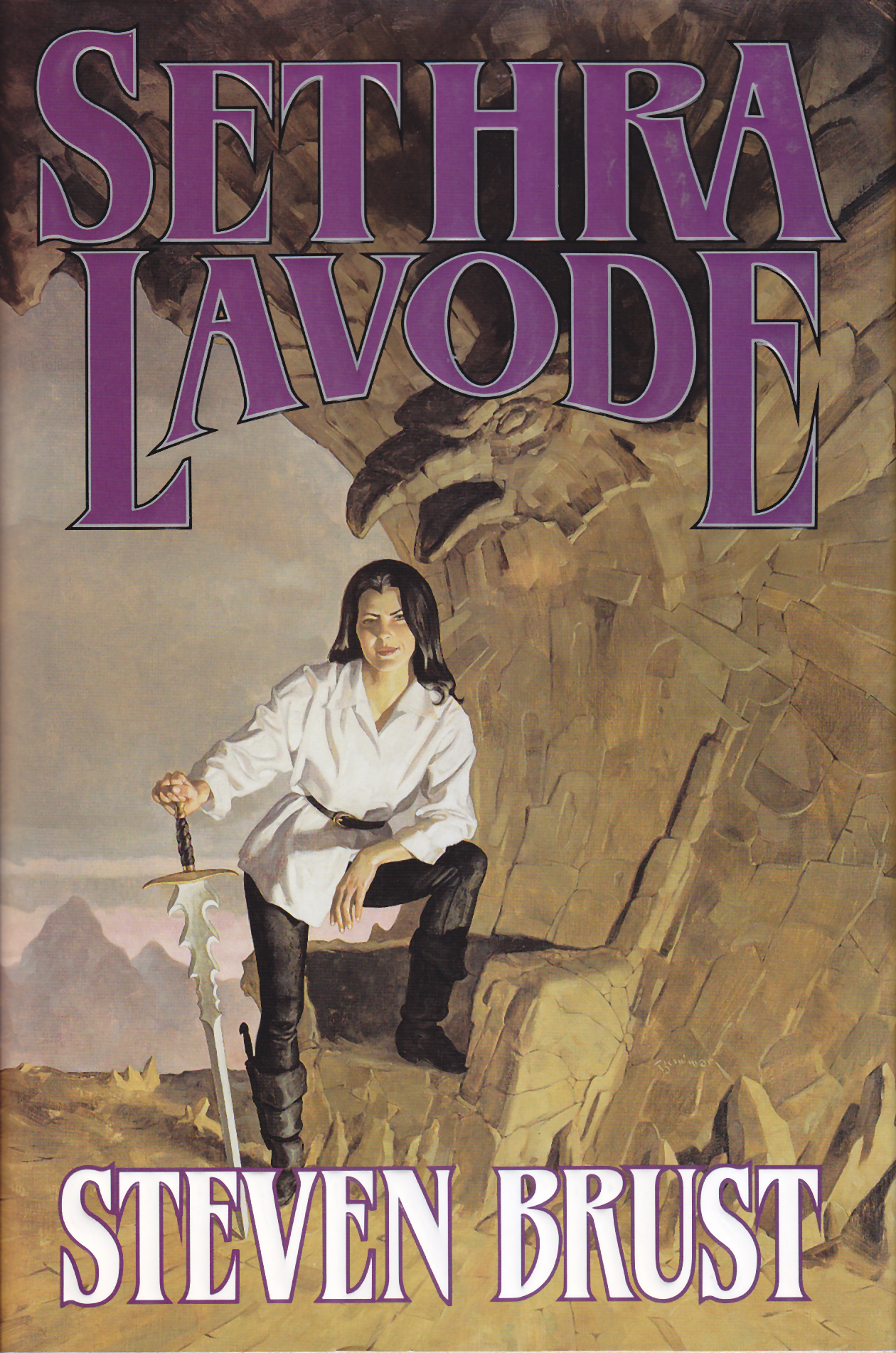 Sethra Lavode concludes The Viscount of Adrilankha trilogy. Morrolan is ensconced in Castle Black and learning Sorcery as well as more about Blackwand, Zerika is settled into Adrilankha and attempting to consolidate power and call a Meeting of Principalities to legitimize her reign, while Kana, who still retains a hold in about a third of the country, continues to attempt to gain power, despite Zerika's possession of the Orb. Meanwhile, Khaavren and Piro are still at odds, an issue that comes to affect his job as Captain of the Imperial Guard, and Sethra Lavode guards against an attack of the Jenoine.
Sethra Lavode concludes The Viscount of Adrilankha trilogy. Morrolan is ensconced in Castle Black and learning Sorcery as well as more about Blackwand, Zerika is settled into Adrilankha and attempting to consolidate power and call a Meeting of Principalities to legitimize her reign, while Kana, who still retains a hold in about a third of the country, continues to attempt to gain power, despite Zerika's possession of the Orb. Meanwhile, Khaavren and Piro are still at odds, an issue that comes to affect his job as Captain of the Imperial Guard, and Sethra Lavode guards against an attack of the Jenoine.
As I like Sethra almost as much as I like Morrolan, I found much to enjoy in this book. We spend time with Sethra, and learn a small bit about her, although many things about Dzur Mountain, including Tukko, remain an enigma. But there are little glimpses of her life.
"I believe, madam, that you have read that book before," observed Tukko. "Not above a hundred times, I believe. But then, it is the mark of a good book that it rewards many readings, is it not?"
Of course the fact that I feel that way about reading has nothing to do about how I feel about that exchange.
And as always there is Steven Brust's excellent writing. Both in the small things that make me laugh:
On this occasion, it being Farmday, the village seemed to Piro to be all but deserted in fact, it might be observed that the arrival of the small company...caused the population of Six Horses to effectively double. Indeed, their arrival would have created something of a sensation had there been a sufficient populace for a sensation to have anything to work with.
As well as with the way he describes things, which, as I've mentioned before, I find nearly perfect.
When they made a move to attack him in a mass, he held out his left hand, all of his fingers stretched out, and, just barely aware of what he was doing, cast a spell which sent from each finger a furious red light, faster than a yendi's strike, and far more deadly; there was a loud cry, and six or seven more of the enemy dropped, each straight down where he stood, not falling backwards or to the side, to lie utterly still, with not so much as a quiver coming from them, as if they had already been dead for some minutes when they fell.
My one complaint is with the cover. This book is Sethra Lavode, and so Sethra should be on the cover, however, excepting the hair, the woman looks like I imagine Aliera (who does not appear in these volumes) to look. And Iceflame is a dagger, not a sword, so that could be Pathfinder, which is described as a short sword. But not Iceflame. Here is the description of Iceflame from Yendi:
(A) long straight dagger, perhaps twelve inches of blade. The metal was light blue, and it emitted a faint glow of that color.
Sorry, but the weapon on the cover is not Iceflame.
And here is the description of Sethra Lavode from Paths of the Dead:
She appeared to be a slim woman, not exceptionally tall, rather gaunt of face, with long black hair that set off the pale skin which was her only remarkable feature. To look at her, one might at first think of her as a Dzurlord from the slant to her eyes and the point to her ears; yet a closer inspection would reveal the bridged nose and high cheekbones characteristic of the House of the Dragon. Further, she had the strong chin that denotes determination, and the close eyebrows which would indicate that she spent a great deal of time in her own company. Her countenance indicated a reserved warmth, if the reader will permit such a formulation.
Furthermore, she is always described as being dressed completely in black.
If Steven Brust didn't do such a good job describing characters and objects, I would be so disturbed by the mistakes on the covers. But he does, and I am.
Aslo, there's a major mistake towards the end of the book, that has Morrolan being in two places at once: participating in the Battle of Adrilankha while he is back East taking care of things there. Talk about being pulled completely out of the story; when I read that I had to stop and go back and try and figure out when Morrolan had come back. The answer: he hadn't.
There were surprises (some unpleasant) even for those who have read the Vlad Taltos books, but as they are surprises, I won't tell you anything about them, other than to mention them so that you know that even when the primary outcome is expected, the author can still provide unexpected events.
All in all, this is a prefect conclusion to the series, as well as to the Khaavren stories, for the final chapter seems to state that there won't be any more Khaavren books (although there will be more Vlad books), so we have to be happy with what we have. Although one may have to hope that at least some of these characters will appear, from time to time, in other stories.
And the Afterword is written by John M. Ford.
- 2004 |
- February 2006 | Rating: 9/10
Characters
Morrolan e'Drien Lord of Southmoor, Arra, Lady Teldra, Sethra Lavode, Sethra the Younger, Sorceress in Green, The Necromancer, Khaavren of Castlerock, Daro Countess of Whitecrest, Piro Viscount of Adrilankha, Zivra/Zerika, Ibronka, Roaana, Kytraan e'Lanya, Tazendra Lavode Baroness of Daavya, Pel/Galstan, Aerich Duke of Arylle, Mica, Tukko, Lar, Clari, Grita, Verra, The Warlock/Viscount of Brimford, Lord Fentor, Princess Sennya Duchess of Blackbirdriver, Marchioness Habil, Count Skinter e'Terics/Duke Kana, Izak, Tsanaali, Illista, Baron Loraan, Blackwand, Iceflame
When I recommend fantasy books, this series is at the top of my list. The books are relatively quick to read, and is written in the tone is that of a hard boiled mystery. And I love mysteries.
The best part about this series, though, is that although it tells the continuing story of Vlad's life, for the most part, each book is a self-contained story, so the books can be read in any order and you are not left hanging at the end of any book.
If you haven't read Steven Brust, this is an excellent place to start. If you've read The Phoenix Guards then you should enjoy the Vlad books, as long as you realize that the writing style is completely different.
Please note that if you have not read the series, you may not want to read the synopses for later books, as they will give away events of earlier books.
Jhereg (1983)
 Comfort reading. Those books that you reach for when you're feeling low, because you know they're guaranteed to take you away from whatever is bothering you.
Comfort reading. Those books that you reach for when you're feeling low, because you know they're guaranteed to take you away from whatever is bothering you.
That's the place that Steven Brust holds in my library.
Jhereg is the first Vlad Taltos book, and also the first Dragaera book. Vladimir Taltos is an Easterner whose father bought a title into the house of Jhereg--the only house that sells it's titles and allows Easterners in. Despite--or perhaps because of--his father's disdain of all things Eastern, Vlad studies fencing and witchcraft from his grandfather, finding himself more suited to them than to the sword work and sorcery of the Dragaerans
It is this unique combination of skills that leads him to eventually take up "work" for the house of Jhereg, and from there to running his own territory with the help of Krager, his Dragaeran partner, and Loiosh, his familiar.
Vlad is a tough guy in a world where everyone else is bigger and stronger than he is, which means he has to be tougher and smarter. Jhereg reads like a hard-boiled mystery with fantasy elements thrown in, something that is more common now, but was unusual when I first came across this book, which was what initially drew me immediately into the story, because I love mysteries, especially the hard boiled type.
Lord Mellar has run off with fund from the Jhereg treasury, and so Vlad is hired to take out Mellar before word of what he did gets out.
Upon re-reading this book for the umpteenth time, I was surprised by how much stuck me. There are so many things that are mentioned in passing in this book, that filled out in later books, either in the Vlad Taltos series, or his Khaavren Romances and The Viscount of Adrilankha series. The Interregnum. Lord Morrolan's study of witchcraft and rise to power. The return of Empress Zerika. Adron's Disaster. I have the feeling that once I finish re-reading the Vlad books, I'm going to have to go back and re-read those other two series.
Additionally, having now read Roger Zelazny, I can see the bits that Steven Brust admired and borrowed, an eventually expounds upon, like Vlad's "Spellbreaker." And you'll have to forgive me, but I like Vlad better much than I liked Corwin.
I also love the cover of this book; Loiosh coming out of his shell. It's otherworldly and dangerous looking, which is the right town for the book.
This book is witty, it's sharp, and it's a lot of fun to read (and re-read).
- 2004 |
- February 2006 | Rating: 10/10
Characters
Vlad Taltos, Loiosh, Kiera the Thief, Vlad's father, Kragar, Aliera e'Kieron, Morrolan e'Drien, Lady Teldra, Sethra Lavode, Cawti, Daymar, Sethra the Younger, Sorceress in Green, the Necromancer, Lord Mellar/Leareth, Rocza, Lord Onnar, Blackwand, Pathfinder, Iceflame, Spellbreaker, Fentor, Norathar e'Lanya, the Demon
Yendi (1984)
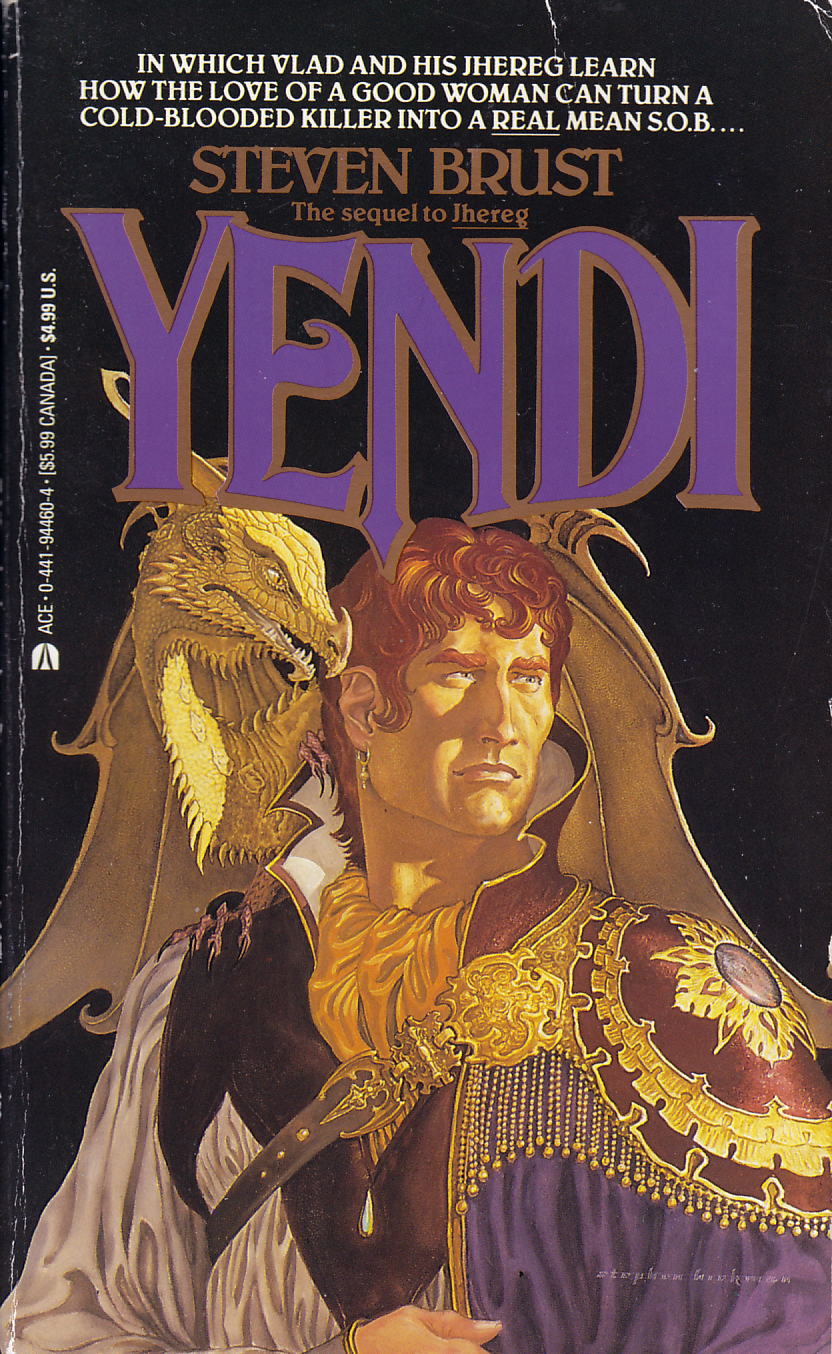 Yendi is the second book in Steven Brust's Vlad Taltos series, however, in the time line it comes before the first book, Jhereg. Instead of taking off from where Jhereg left off, we go back in time, to when Vlad met Cawti, his future wife.
Yendi is the second book in Steven Brust's Vlad Taltos series, however, in the time line it comes before the first book, Jhereg. Instead of taking off from where Jhereg left off, we go back in time, to when Vlad met Cawti, his future wife.
Yendi are devious and delight in intricate plots, and so the plot of Yendi is intricate and devious. Someone is trying to take over Vlad's territory, and seems willing to take any means necessary to gain that territory. However, the more Vlad looks into what is happening, the more suspicious he becomes of what is going on.
I also love the fact that he throws in little jokes, such as the following exchange:
"Vladimir," said Cawti, "how should we approach (the sorceresses)?"
"Yes," said Morrolan dryly. "You wouldn't want her to turn you into a newt."
"I'll get better," I said.
One thing I hate, however, is the cover of this book. Vlad is described as black haired, with a mustache, and wearing Jhereg black and gray. The individual on the book is red haired, clean shaven, and wearing white and purple. I'd have thought that it was supposed to be a different character, except for the jhereg on his shoulder. Bah. Unfortunately, the reissues are just as bad, with the same, red-haired impostor on the covers. How miserable.
Luckily, the quality of the cover does not reflect upon the quality of the contents. Vlad, Aliera, Sethra Lavode, and Morrolan are again wonderful. I love Steven Burst's characters. I don't know how he does it, but the dialog is sharp and witty, although I have to admit that I prefer the parts with Morrolan and Aliera more than when Vlad is dealing with his enforcers. It's not that he doesn't get the wise-guy banter right. I just prefer the other.
Although Jhereg is the best place to start the Vlad Taltos series, you could certain start here without any difficulty if you so desired.
- 2004 |
- February 2006 | Rating: 9/10
Characters
Vlad Taltos, Loiosh, Aliera e'Kieron, Morrolan e'Drien, Lady Teldra, Sethra Lavode, Cawti, Norathar e'Lanya (Lady Miera & Lord K'laiyer), Kragar, Laris, Kragar, Melestav, Sticks, Glowbug, Ishtvan, Devera, Iceflame, Blackwand, Spellbreaker, Sorceress in Green, Sethra the Younger, the Necromancer, Niosh-pa, Toronnan, Valabar's, Fentor
Teckla (1987)
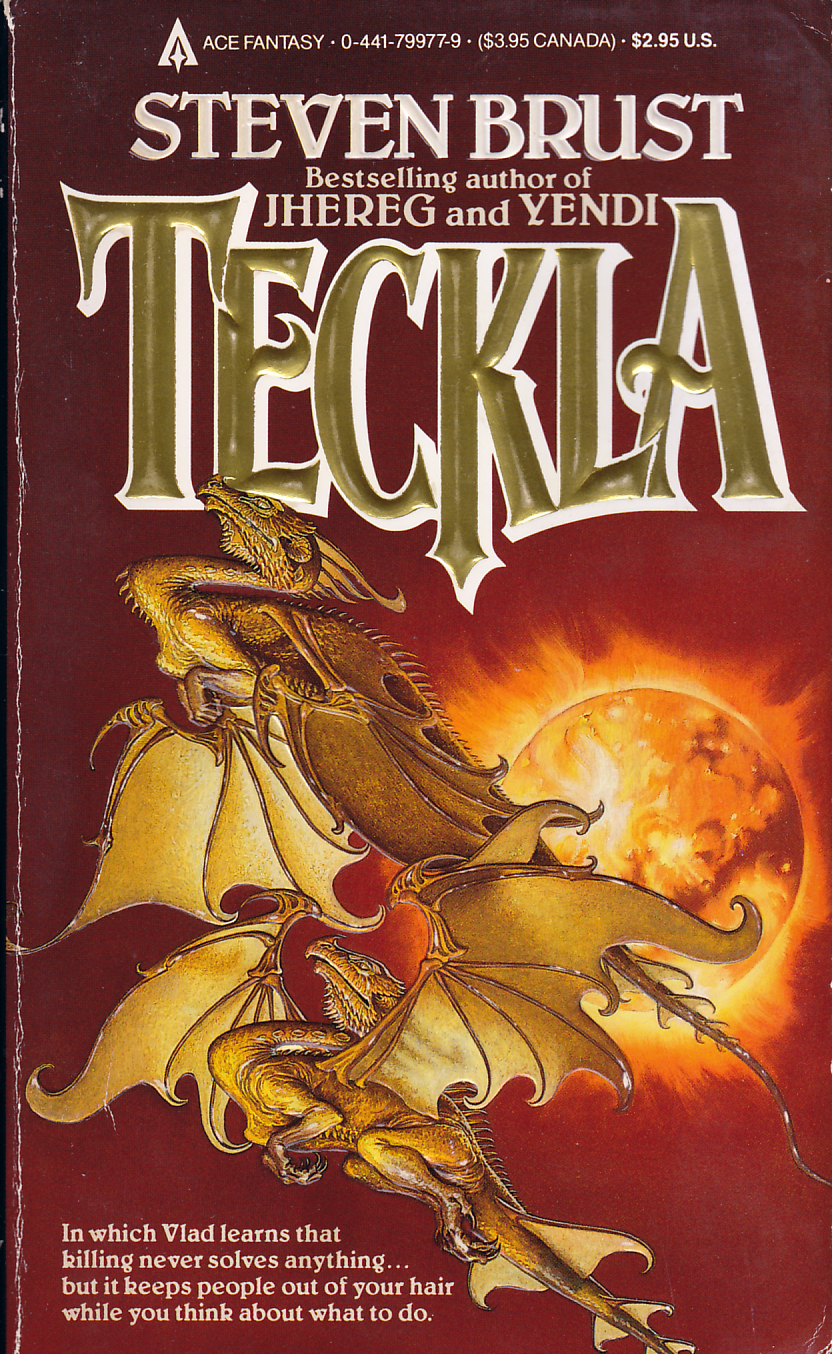 In case you were thinking that I love absolutely everything that Steven Brust has written, this book is the proof that I don't.
In case you were thinking that I love absolutely everything that Steven Brust has written, this book is the proof that I don't.
Back to the continuing time-line, the book follows immediately after the events of Jhereg. Unlike previous books, this story involves on the Jhereg, the jhereg, Cawti, Vlad, and various Easterners and Teckla. For me, the addition of Vlad's grandfather, Niosh-pa, whom I like a lot, doesn't make up for the fact that we spend no time with Morrolan and Aliera and Sethra in this book. In fact, we don't even get to see Kiera.
Additionally, this book is about Vlad and Cawti's marriage starting to fall apart. Cawti is at loose ends. Her partnership with Norathar ended with Norathar was reinstated to the Dragon house, became the Dragon heir, so Cawti has been looking for something to do while Vlad runs his business.
The problem is that Cawti become involved in a group seeking to end the oppression of Easterners and Teckla. This places Vlad and Cawti at odds, as the group attracts the attention of the Jhereg who run that area, and the Jhereg attempt to deal with this problem in the way they know best.
This is not a fun book. It's a dark, angry, and unpleasant book. This doesn't mean that it isn't a good book, it is just not the book that I particularly want to read. Unfortunately, you must read this book to understand the events of later books. Skipping this book would be a serious mistake, however skipping this book as you reread the series, is perfectly fine. The writing and dialog remains excellent, as does the plotting. This is simply not a story that I enjoy reading.
In fact, I did a good deal of skimming, because the book is simply far darker and uglier than I want to deal with. As I said about Jhereg, the Vlad series is comfort reading for me, but this book is not comforting. In fact, Teckla reminds me of may least favorite Spenser book, A Catskill Eagle. In both books, the main character's partner goes off the deep end, and takes the main character with her. Although I find less to dislike about Cawti than I do about Susan, I still find them both irritating in their respective books. I realize that we are supposed to find sympathy for Cawti, but I just don't.
Though it was fun, seeing Khaavren for the first time, even if at the end of his career.
If you are reading the Vlad Taltos series for the first time, you must read this book to understand later books. And it is a well-written book. However, if you are expecting the light, fun romp of the previous two books, get used to disappointment.
- 2004 |
- February 2006 | Rating: 5/10
Characters
Vlad Taltos, Cawti, Khaavren, Loiosh, Rocza, Niosh-pa, Ambrus, the Demon, Gregory, Padraic Kelly, Franz, Sheryl, Paresh, Herth, Bajinok, Sticks, Glowbug, Kragar, Spellbreaker, Melestav, Ishtvan
Taltos (1988)
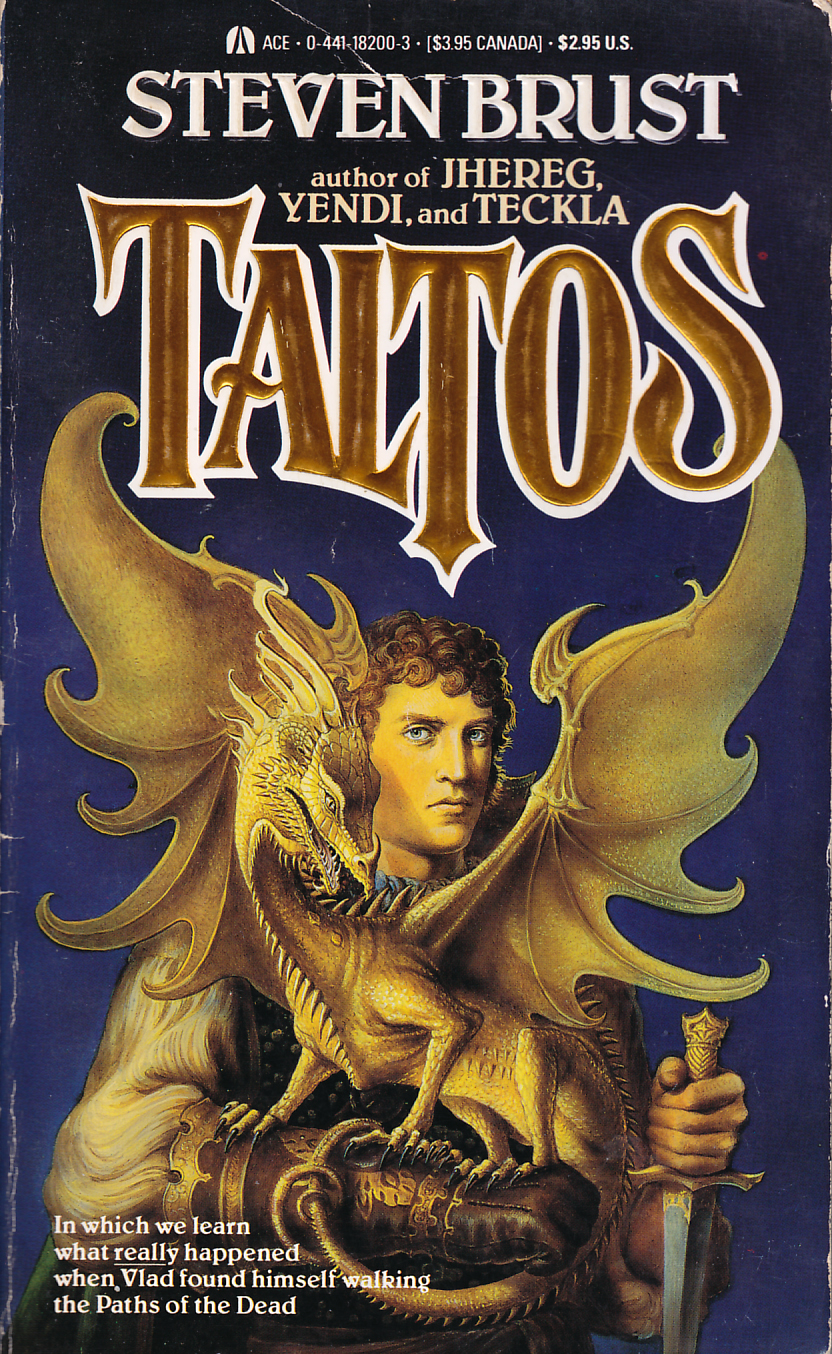 With great relief I picked up Taltos, which again tells some of Vald's history, and returns to the tone of the first two books. Taltos is fun and amusing, especially as Vlad and Morrolan get to know each other and learn to work together. It is also interesting to see Vlad's first impressions of Morrolan and Sethra.
With great relief I picked up Taltos, which again tells some of Vald's history, and returns to the tone of the first two books. Taltos is fun and amusing, especially as Vlad and Morrolan get to know each other and learn to work together. It is also interesting to see Vlad's first impressions of Morrolan and Sethra.
I was beginning to get downright irritated, as well as frightened, by how close (Morrolan's) guesses were. I mean, what a pompous, supercilious jongleur. But the thought came to me that he was a pompous, supercilious jongleur with a very powerful Morganti blade, and he was a sorcerer, and I was in his keep. I resolved to stay polite.
Taltos is set before Yendi, and tells of Vlad's first meeting with Morrolan and Sethra Lavode. And during the telling of that tale, he reminiscences about his youth, the tutoring he received in fencing and witchcraft he received from his grandfather, how he started working for the Jhereg, and how he started taking "work."
Although Vlad discusses in detail his work as an enforcer and then an assassin, the tone of the book is far lighter than than of Teckla. Perhaps because in fantasy you're used to people getting killed (especially if you're reading a book about an assassin). It may also have to do with the presence of Morrolan, Sethra, and Aliera. Although Vlad starts out hostile towards Morrolan and Sethra (with good reason), you can see him being to trust the two of them, and eventually Aliera, and how their eventual friendship will develop.
As always, the dialog and storytelling were excellent, and as an added bonus, I quite enjoyed this story. It is also interesting to continue to learn bits and pieces of Krager, who is amusing, as well as an enigma.
However, as much as I liked this book, I again hate the cover. Who is this guy? This clean-shaven brunette? It can't be Vlad, who is extremely proud of his moustache, since the Dragaerans can't grow facial hair. The colors aren't quite as obviously bad, although he looks as if he's wearing white and brown. (Black and gray. Jhereg colors are black and gray.)
If you have not read any of the Vlad Taltos series, this would be an acceptable place to start, as this is the earliest book in the time line.
- 2004 |
- February 2006 | Rating: 9/10
Characters
Vlad Taltos, Loiosh, Niosh-pa, Ambrus, Vlad's father, Sethra Lavode, Morrolan e'Drien, Aliera e'Kieron, Spellbreaker, Loraan, Quion, Lord Baritt, Verra, Barlan, Lady Teldra, Kragar, Kiera the Thief
Phoenix (1990)
 Chronologically, Phoenix follows Teckla. Verra, the demon goddess, has “work” for Vlad. She wants the king of Greenaere killed, and she refuses to say why. Vlad and Cawti are still at odds, with no reconciliation on the horizon, as Cawti's actions with the revolutionary group continue to place her in danger, and Vlad's opposition to anyone harming her places him at odds with the Jhereg.
Chronologically, Phoenix follows Teckla. Verra, the demon goddess, has “work” for Vlad. She wants the king of Greenaere killed, and she refuses to say why. Vlad and Cawti are still at odds, with no reconciliation on the horizon, as Cawti's actions with the revolutionary group continue to place her in danger, and Vlad's opposition to anyone harming her places him at odds with the Jhereg.
Although Phoenix is not as depressing as Teckla, it is still a dark book. Morrolan and Sethra and Aliera all appear in this book, which to some degree helps alleviate some of the tension, but there is still the underlying issue of Vlad and Cawti's marriage falling apart, and there's little one can do to make that easy to read, other than keep Vlad distracted with other things.
Vlad meets a Greenaere drummer, and for various good reasons, ends up bring him back to Adrilankha. Aibynn is a strange character, and I never did figure out what I thought about him and how I felt about him, which is unusual, since Steven Brust's characters usually evoke some response, one way or the other, from me.
This is, like Teckla, not a book that I particularly like to read, however, like Teckla, it is also an incredibly important book. If you attempt to skip this book, you'll have lost a major thread of the story.
- 2004 |
- February 2006 | Rating: 6/10
Characters
Vlad Taltos, Loiosh, Sethra Lavode, Morrolan e'Drien, Aliera e'Kieron, Blackwand, Pathfinder, Iceflame, Padraic Kelly, Empress Zerika, Verra, Devera, Count Soffta, Lady Teldra, Norathar e'Lanya, Daymar, Kragar, Sticks, Glowbug, Melestav, Aibynn, King Corcor'n, Niosh-pa, Ambrus
Athyra (1993)
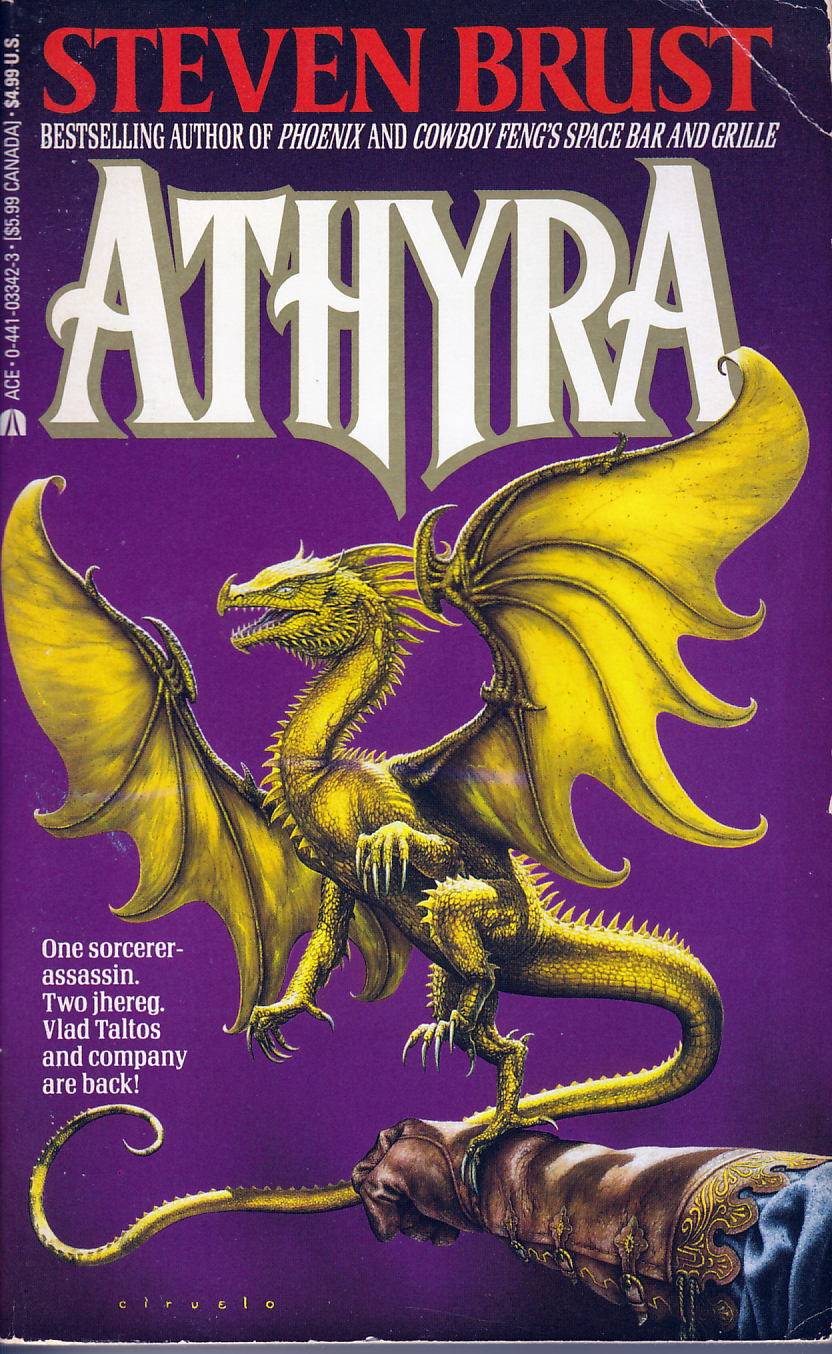 Once you get past the fact that it is not written from Vlad's point of view, Athyra is a very good book. The story is told from the point of view of Sven. It's not first person like the other Vlad books, but we know Sven's thoughts and feelings and impressions as he eventually meets Vlad. It also has several passages from the point of view of Rocza, which I found very interesting. After all, unlike Liosh, she came to Vlad full grown, and is still a wild creature.
Once you get past the fact that it is not written from Vlad's point of view, Athyra is a very good book. The story is told from the point of view of Sven. It's not first person like the other Vlad books, but we know Sven's thoughts and feelings and impressions as he eventually meets Vlad. It also has several passages from the point of view of Rocza, which I found very interesting. After all, unlike Liosh, she came to Vlad full grown, and is still a wild creature.
Chronologically, Athyra follows Phoenix. Vlad is on the road, and still on the run from the Jhereg. He wanders into the village near Smallcliff, and almost immediately, someone turns up dead. As a stranger--and an Easterner--suspicious immediately falls upon Vlad. Vlad tells Sven that although he knew Reins, he was not directly responsible for his death.
As I said, it is a bit of a shock to read Vlad's story from someone else's point. But once you get past it, the story is interesting. So far it is the only book written from the point of view of a Teckla, and unlike the other books that have Teckla, this one is entirely sympathetic. (As much as I love The Phoenix Guards and Five Hundred Years After, the Teckla seem there for humor and to lightly make fun of, rather than as characters that we should care about.
And it is an interesting point of view. Sven is a peasant who is learning to be a healer, and unlike those from the big city of Adrilankha, is concerned with things of a rural nature: the harvest, his apprenticeship. It is a very different point of view of Dragaera than any of the other books, which is one of the things that makes it so interesting.
Additionally, the cover somewhat gives away the tone of the book, although I didn't notice it initially. The Jhereg landing on the arm of a man who is all but unseen, off the edge of the cover.
Like Teckla, this book is quite different from the other books in the series, unlike Teckla, the story is not as painful to read--for one thing, all of Vlad's suffering is viewed through Sven's eyes, and that distance makes things a little easier.
- 2004 |
- February 2006 | Rating: 7/10
Characters
Vlad Taltos, Loiosh, Rocza, Savn, Master Wag, Polyi, Ishtvan, Baron Loraan Smallcliff, Sara
Orca (1996)
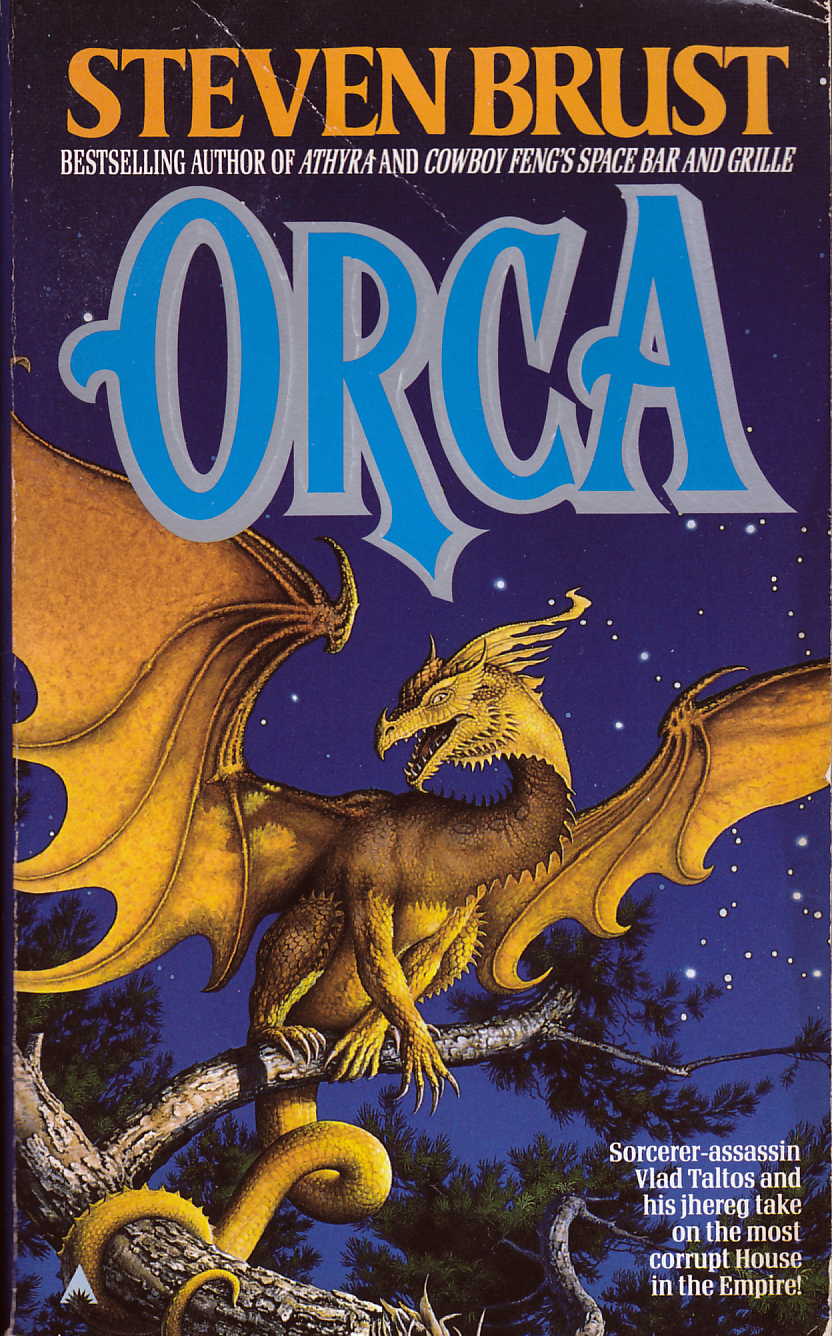 Set about a year after the events of Athyra, Vlad has wandered into Northport in search of a sorcerer who might be able to cure Sven, the Teckla boy who lost his mind during the events of Athyra. He finds one, however, her price is keeping her from being evicted from her house. To do this, Vlad has to enlist the help of Kiera the Thief, and hope that she holds their friendship higher than the needs of the Jhereg.The point of view switches from Vlad to Kiera, as Kiera relates the entire incident to Cawti, back in Adrilankha.
Set about a year after the events of Athyra, Vlad has wandered into Northport in search of a sorcerer who might be able to cure Sven, the Teckla boy who lost his mind during the events of Athyra. He finds one, however, her price is keeping her from being evicted from her house. To do this, Vlad has to enlist the help of Kiera the Thief, and hope that she holds their friendship higher than the needs of the Jhereg.The point of view switches from Vlad to Kiera, as Kiera relates the entire incident to Cawti, back in Adrilankha.
With Orca, Steven Brust again shifts his manner of storytelling, however, we are dealing with familiar characters, and so the feel of the story is similar to earlier books.
There are any number of things that I like about Orca. I like Kiera. I like the fact that Vlad is doing something to help Svan. And I really like the story. There's danger! Intrigue! Excitement! and everything makes sense in the end. Additionally, I like the multiple surprises at the end. As I'd read the book before, this time I was looking for hints as to the secrets. They were there, but I don't think I would have guessed on my own. Actually, I'd been looking for hints as I read the series, so see if there was any hints earlier.
As usual, the storytelling is excellent. Combine that with the fact that Vlad is again starting to deal with characters I like and have missed, and you have another excellent story. The intrigue of the plot that Vlad must unravel is also fascinating, although I have to admit that I may find failing banks and deals a little more interesting than the average person.
Although I miss Morrolan and Sethra and Krager, it was good to see Kiera again. Vlad is always a little more wittier when he has a sharp wit to duel with.
Again, this is not the place to be jumping into the story. You'll want to start at Jhereg or Taltos if you're not already familiar with Vlad. However Orca is an excellent addition to the series, especially as it expands on Vlad's character without doing horrible things to him.
- 2004 |
- February 2006 | Rating: 8/10
Characters
Vlad Taltos, Loiosh, Rocza, Savn, Kiera the Thief, Lord Fyres, Side-Captain Vonnith, Cawti, Hwdf'rjaanci, Reega, Timmer, Lieutenant Domm, Shortisle, Stony, Loftis, Daythiefnest, Endra
Dragon (1998)
 I really like Dragon. It's fun, it's well-written, and I particularly like some of the observations that Vlad makes about life and war.For the most part, Dragon takes place soon after Taltos, however, a few parts of the story take place after Yendi. And if you think that's confusing, you're right.
I really like Dragon. It's fun, it's well-written, and I particularly like some of the observations that Vlad makes about life and war.For the most part, Dragon takes place soon after Taltos, however, a few parts of the story take place after Yendi. And if you think that's confusing, you're right.
Vlad is relating events that occurred soon after Taltos, however, his time frame as he tells his story is soon after Yendi. The storyteller Vlad has met, but not yet married Cawti, and he is telling his part in the War of Baritt's Tomb, which occurs soon after he met Morrolan and Sethra, years before he met Cawti.
I enjoyed this book as a whole, and I particularly liked the parts about the battles and the war. As Vlad relates his impressions and feelings about his part in the war, he also relates what Sethra told him later about the war. So we get it from a micro and a macro perspective. The confusion and chaos experienced by an individual soldier, and the overall plans and ideas of the general in charge of the war itself. I found the combination of the two to be very interesting as well as thought provoking.
I also liked learning yet another story from Vlad's past. This time, how he comes to provide security for Morrolan, and how he ended up in the middle of a war between two Dragons (one of whom is Morrolan). We also learn a little bit more about Spellbreaker, and finally meet one of the Serioli. Oh, and we get to finally see Vlad's first meeting with Daymar, which is pretty much how he described it in the past, yet still unexpected.
I enjoyed Vlad's musings upon the motivations of Dragons, and his thoughts on war and battle, especially his feelings as compared to those of his Dragon companions.
One negative, however, is that I did find the jumps back and forth in time confusing. As Vlad was relating his memories of what had happened, they are intertwined with his musings on what is happening to him currently. There were several passages where I became confused about the time line, as he moved not years in the past, but only a few days or hours. In one passage in particular the time shifted in the middle of a paragraph, and I was left trying to figure out why Vlad was contacting Krager to discuss how things are going back at the office when he's in the middle of a battle.
However, aside from that, this books was, for me, pretty much perfect. We got to see Morrolan and Aliera and Sethra, and watch their relationships with Vlad evolve into what we saw in other books. We also see more of his relationship with Cawti, although I was disappointed that we don't really see anything that gives us any hint of how things are going to end up later.
Although this would be an acceptable place to start the series, it might be slightly less confusing if you have read Taltos and Yendi, simply because it might make the story lines a little easier to follow.
Despite the confusion, this is still a fun book to read, and one which I thoroughly enjoyed.
- 2004 |
- February 2006 | Rating: 9/10
Characters
Vlad Taltos, Loiosh, Morrolan e'Drien, Aliera e'Kieron, Sethra Lavode, Blackwand, Pathfinder, Iceflame, Spellbreaker, Cawti, Niosh-pa, Kragar, Daymar, Lady Teldra, Sethra the Younger, Napper e'Drien, Virt, Aelburr, Captain Cropper, Count of Fornia, Ori, Kragar, Fentor, the Necromancer
Issola (2001)
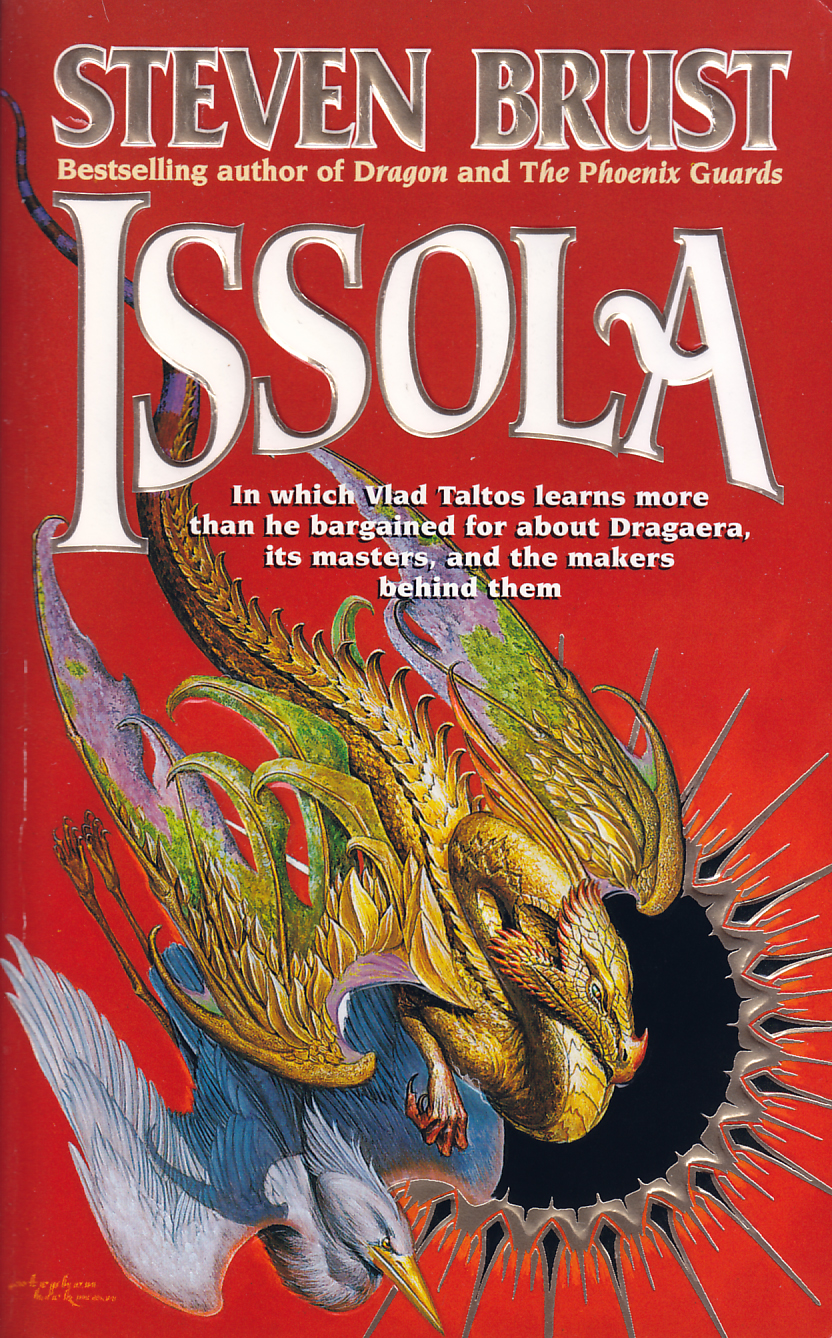 Issola, for reasons about which I am not quite clear, is one of my favorite Vlad books. I think it's because I like Lady Teldra so much, but it could also be the fact that Vlad is back to spending time with with Morrolan and Aliera and Sethra Lavode.
Issola, for reasons about which I am not quite clear, is one of my favorite Vlad books. I think it's because I like Lady Teldra so much, but it could also be the fact that Vlad is back to spending time with with Morrolan and Aliera and Sethra Lavode.
Set after Orca, Lady Teldra finds Vlad to ask for his help, because Morrolan and Aliera have both disappeared, and Sethra thinks that Spellbreaker has a connection to Pathfinder that will allow them to find Aliera and Morrolan.
As I said, I very much like Lady Teldra, and I enjoy the conversations that Vlad has with her, especially those on the nature of courtesy and appropriateness.
But you are always, or nearly always, correct in which (action) you choose. And this is not a matter of instinct, but of observation, attention to detail, and experience. Appropriate action means to advance your own goals, without unintentional harm to anyone else.
Strange as it may be, the Issola--or at least Lady Teldra--is the Dragaeran house that I most closely identify with. Does this mean that I'm courteous and appropriate? Nope. (But you knew that already) But that I value these things more than I value the traits of some of the other houses. So perhaps someone who prefers the traits of the Dragon or Dzur might like this book less. Maybe.
Regardless, I really enjoy this book. As with the other books, I love the characters, the storytelling is excellent, and I really like the story itself. Plus we learn a lot of things about the Gods and the Jenoine and Great weapons that I find very interesting.
There are a few slow parts, but within those slow parts are the conversations that Vlad and Teldra have that I like so much, so I can live with them. And the ending is slightly confusing. I had to read it slowly and carefully to make sure I caught everything that was happening, because there is a lot going on, all of which you need to pay attention to.
And again, this is another cover that I particularly like. The jhereg and the issola are a nice touch, and the red cover just somehow seems appropriate, even if green and white are the house colors of the Issola.
If you are looking for a place to start the Vlad Taltos series, I would recommend an earlier book, either Jhereg or Taltos, not because you will find this book confusing without the background of the other books, but because you will find it more enjoyable knowing the past of these characters.
- 2004 |
- February 2006 | Rating: 9/10
Characters
Vlad Taltos, Loiosh, Rocza, Lady Teldra, Morrolan e'Drien, Aliera e'Kieron, Sethra Lavode, Blackwand, Pathfinder, Iceflame, Spellbreaker, Verra, Barlan, the Jenoine, the Necromancer, Adron e'Kieron
Dzur (2006)
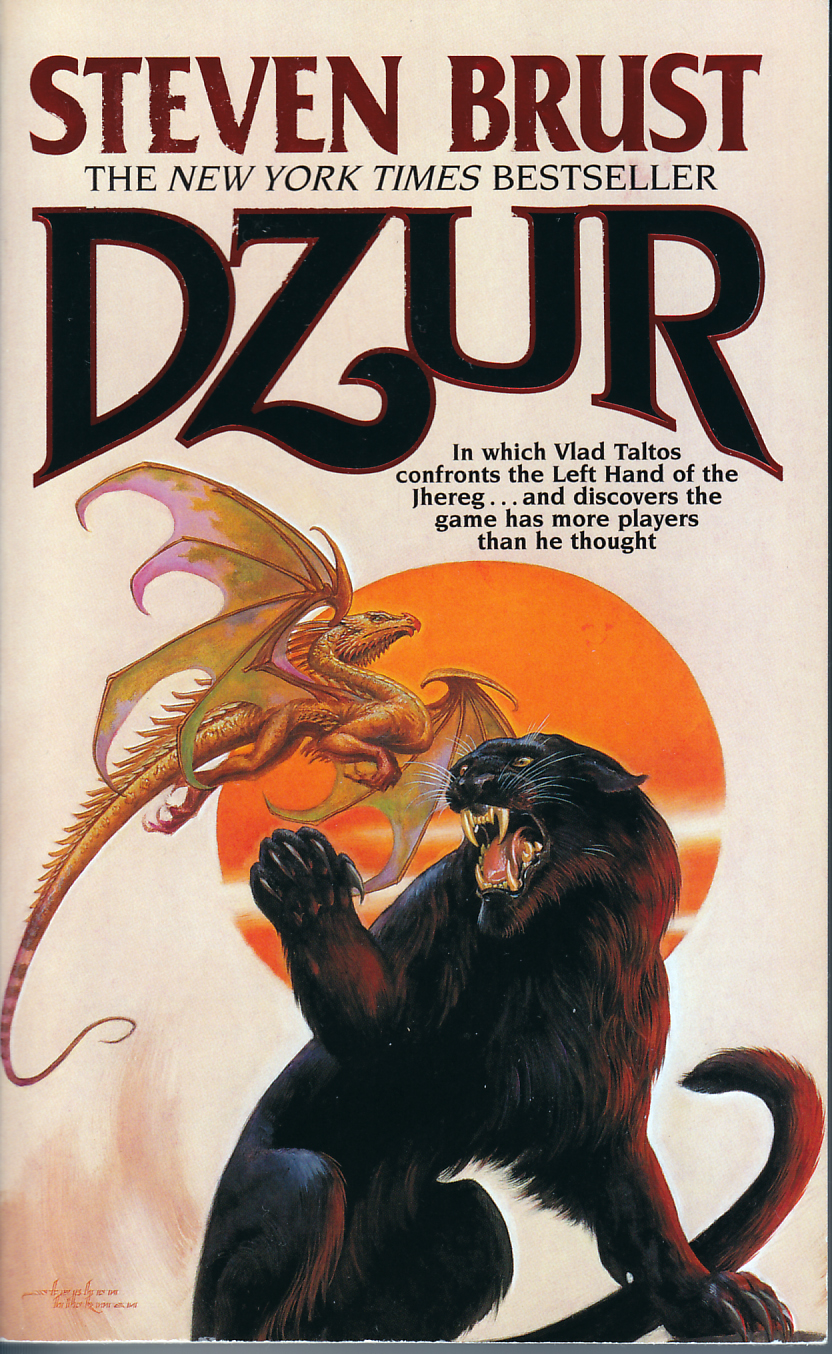 I've been reading Steven Brusts Vlad Taltos novels since about 1994, and I've been snatching them up eagerly as they've come out–at least until Dzur. Not because I don't still love Vlad, but because I love reading this books, and don't like reading hardback. So I decided to bite the bullet and wait until it came out in paperback. (One, I didn't want to buy it twice [no matter how much I love Steven Brusts writing], two, because a hardback would ruin my organization, forcing the on to be placed not with the rest of the series, but with the hardback books, and three, because I just don't like enjoy reading hardback books. And as often as I re-read this series, I wanted to make sure I'd be able to curl up with this book, just like I do the rest of the series.)
I've been reading Steven Brusts Vlad Taltos novels since about 1994, and I've been snatching them up eagerly as they've come out–at least until Dzur. Not because I don't still love Vlad, but because I love reading this books, and don't like reading hardback. So I decided to bite the bullet and wait until it came out in paperback. (One, I didn't want to buy it twice [no matter how much I love Steven Brusts writing], two, because a hardback would ruin my organization, forcing the on to be placed not with the rest of the series, but with the hardback books, and three, because I just don't like enjoy reading hardback books. And as often as I re-read this series, I wanted to make sure I'd be able to curl up with this book, just like I do the rest of the series.)
So although I waited until Dzur came out in paperback, I also have had it on pre-order since last spring. And when I found it by my door last night, I started reading almost as soon as I tore the box open.
How does Dzur fit into the series? It's set immediately (and by immediately I mean no more than a few hours later) after the events of Issola. It begins with Vlad's long dreamed for meal at Valibar's, and every chapter starts with a description of a course of that meal. So don't read Dzur if you're hungry. You'll regret it. (Despite having just eaten, at about the midpoint of the book I wanted to go out to a really good restaurant and have a really good meal. Because my stomach was starting to get jealous.) Unfortunately, Vlad's meal is interrupted–not by an assassination attempt, but by the appearance of someone we haven't seen since Five Hundred Years After. And this someone has information for Vlad that changes his plans of coming to town for a meal at Valibar's then leaving immediately for somewhere else before he's spotted.
The nice thing about Dzur is we get to spend time with some characters we haven't seen for awhile, including Kiera the Thief and Kragar. We also see Cawti, but as expected, those meetings are not necessarily satisfactory.
There were six years between Issola and Dzur. Was it worth the wait? Yes and no. I enjoyed the story, and it was a nice addition to the series, but it wasn't quite as good as Issola, Jhereg, and Dragon. But it was nowhere near as dark as Teckla and Phoenix, two of my least favorite books in the series. But for anyone following the series, this is going to be required.
Although some of Vlad's biggest problems remain unresolved, the story arc of this book is completed (always important as far as I'm concerned) and we come to the realization that some of Vlad's problems may never be resolved in a satisfactory manner. I also liked the book didn't take the easy way out and attempt to solve some of Vlad's problems with a quick and dirty (and ultimately unsatisfactory) solution. So major kudos for that.
Am I impatient already for the next book? Most definitely, especially since I know that Jhegaala has already been edited, and he's currently writing Iorich. Impatient enough to buy them in hardback? Probably not. But it's good to know more Vlad books are in the works and we won't have to wait six years for the story to continue.
If you have not before read a Vlad book, this is not the best place to start. You should be able to follow along, but you'll really be missing out, not just on the back story, but also on the context of many of the comments.
November 2007 | Rating: 8/10
Characters
Vlad Taltos, Loiosh, Rocza, Lady Teldra, Sethra Lavode, Iceflame, Verra, Kiera, Cawti, Valibar's Restaurant, Kragar, Mario Greymist
Jhegaala (2008)
 First things first, I love Steven Brust, and I love the Vlad Taltos books.
First things first, I love Steven Brust, and I love the Vlad Taltos books.
That said, this is not anywhere close to being one of my favorite books in the series.
Jhegalla is set between the events of Phoenix and Athyra. We learn some of what happened to Vlad after he and Cawti divorced, and he went East to hide from the Jhereg. We know something bad happened, because those events are alluded to in later books, but we never knew precisely what happened, until now.
Despite my love of all things Vlad, this books feels much like Teckla (one of my least favorite Vlad books) did. It doesn't feel like a Vlad story as much as it feels like Steven Brust working through his own issues through Vlad.
That doesn't mean this was a horrible book, after all Steven Brust remains a master of dialogue and story telling, but it didn't draw me in the way other books in the series have. I wanted to know what happened to Vlad, and I enjoy the banter between Vlad and Liosh, but this is not a book I would recommend to someone interested in starting the series.
Of course Vlad fans will want to learn what happened to him during those missing years, but if you've heard good things about the Vlad Taltos series, begin at Jhereg. You'll eventually want to read Jhegaala to fill in the missing pieces, but if you begin here I fear you won't want to read more of the series.
July 2009 | Rating: 7/10
Characters
Vlad Taltos, Loiosh, Rocza
Iorich (2009)
 Vlad is once again back in Dragaera City. Aliera has been arrested for practicing elder sorcery. Yes, she has been doing so for years, but so have many other people, none of whom has been arrested.
Vlad is once again back in Dragaera City. Aliera has been arrested for practicing elder sorcery. Yes, she has been doing so for years, but so have many other people, none of whom has been arrested.
Although Aliera has friends–many powerful friends–their positions in court and the stability of the empire, combined with Aliera's stubbornness, keep them from coming to her aid, so Vlad takes it upon himself to do so.
I've loved the Vlad books since I picked up my first years ago. I've read and reread them all for the world and the characters but more importantly for the dialog. I'm a tremendous fan of hard boiled mysteries, and that's precisely how the Vlad books read, witty dialog and all.
And yet…
It felt like there was something missing from this book.
Vlad is witty as always. Liosh is fun and enjoyable. They both get into tremendous amounts of trouble, and yet…
Do I grow tired of Vlad? I suppose that could be it, yet the earlier books still draw me.
I think it is a combination of several things. Vlad is still on the run. We spent books and books hearing about how his life was forfeit and that's why he has scrupulously avoided the city. Yet here we have an entire book where he not only spends time in the city but wanders around and even makes his presence known.
I really do not understand how he survived this book. By all rights he should not have, yet there were not even any serious attempts made upon him. And I think that got to me after awhile. All those years of Vlad wandering in the desert seemed unnecessary, since he can apparently wander at will around Dragaera City without (much in the way of) harm.
It just felt… wrong.
And to top it off, After waiting for more than a year, they canceled the mass market paperback printing and instead made a trade paperback edition. As I've said before, I like paperback books and will wait a year or more for a book rather than having to end up with a hardback. So now I have a book I don't know how I feel about, in a format different from the rest of the books in the series.
Bah humbug.
If you're a Vlad fan, you've almost certainly already read this, but finishing this book made me want to go back to the earlier books, to see if I have changed or if the series has.
February 2011 | Rating: 6/10
The Desecrator (2011)
 This is a short story set in Dragaera. It features both Daymar and the Dzur Zungaron/Telnan.
This is a short story set in Dragaera. It features both Daymar and the Dzur Zungaron/Telnan.
It's only a dollar! If you've read Steven Brust, you know you want it!
Published by Tor
Anthologies
The Sandman Book of Dreams (1996) edited by Neil Gaiman and Ed Kramer
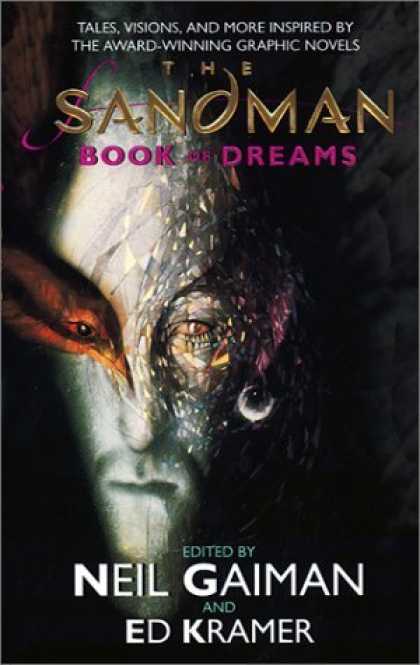 Masquerade and High Water by Colin Greenland
Masquerade and High Water by Colin Greenland- Chain Home, Low by John M. Ford
- Stronger Than Desire by Lisa Goldstein
- Each Damp Thing by Barbara Hambly
- The Birth Day by B.W. Clough
- Splatter by Will Shetterly
- Seven Nights in Slumberland by George Alec Effinger
- Escape Artist by Caitlin R. Kiernan
- An Extra Smidgeon of Eternity by Robert Rodi
- The Writer's Child by Tad Williams
- Endless Sestina by Lawrence Schimel
- The Gate of Gold by Mark Kreighbaum
- A Bone Dry Place by Karen Haber
- The Witch's Heart by Delia Sherman
- The Mender of Broken Dreams by Nancy A. Collins
- Ain't You 'Most Done? by Gene Wolfe
- Valóság and Élet by Steven Brust
- Stopp't-Clock Yard by Susanna Clarke
- Afterword: Death by Tori Amos
It took me several months to read this book, not because it was boring, but because I was carrying it back and forth to work to read at lunch, or if I had to go somewhere for an appointment. This means that as I finished the last story in the book, I could barely remember the first story in the book.
I of course loved Steven Brust's Valosag and Elet, but then I tend to love everything that Steven Brust writes, so you'll have to consider the source. One of the stories merits is that it is written as a folktale, and since I love folktales, that made it all the more endearing.
There was so much more that I wanted to say about these stories, but it's been over a month since I finished the collection, so I best say this for now, lest I forget everything.
These were stories written in the world of the Sandman, but they were not written by Neil Gaiman. If you liked Sandman and like short stories, then you'll like this collection. But if you are looking for more of Neil Gaiman's writing, or know little or nothing of The Sandman, then this collection is probably not for you.
Published by Harper Torch
The Essential Bordertown (1998) edited by Terri Windling & Delia Sherman
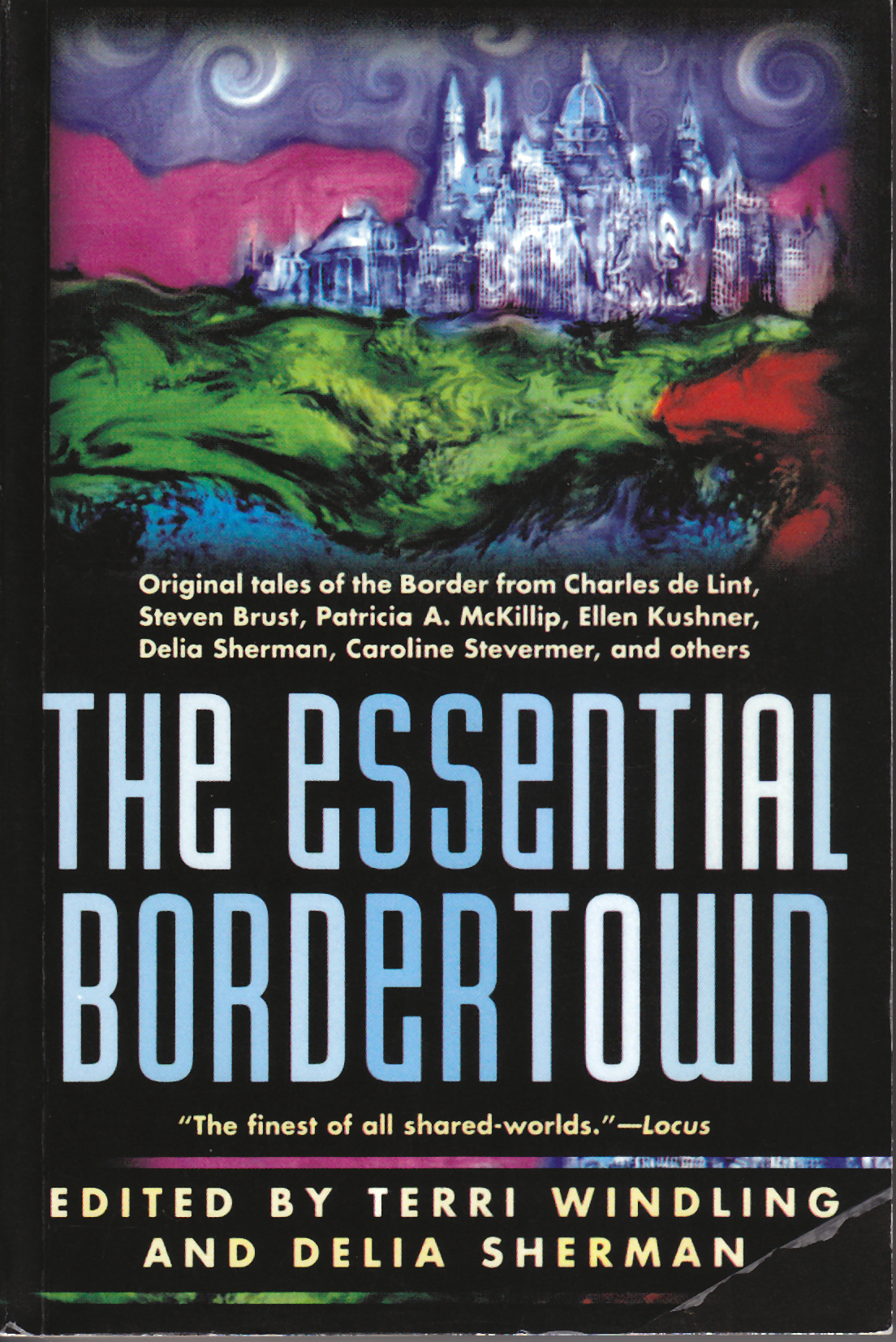 The Essential Bordertown is a collection of short stories set in Bordertown, the land between our world and Faerie. The stories are written with a teenage audiences in mind, with primarily teenage characters, and parts of a “traveler's guide” appearing before each chapter.
The Essential Bordertown is a collection of short stories set in Bordertown, the land between our world and Faerie. The stories are written with a teenage audiences in mind, with primarily teenage characters, and parts of a “traveler's guide” appearing before each chapter.
Bordertown strikes me as a cross between Sanctuary of Thieves' World and the world created by Charles de Lint. It's the area where faerie and the world of humans meets, and it's a strange place where neither magic or technology works properly, and although there are some places where elves and humans meet and get along, there are roving gangs of elves and humans who rule different parts of town, and woe to the opposite race who wanders into their territory.
- Oak Hill by Patricia A. Mckillip
- Dragon Child by Midori Snyder
- Socks by Delia Sherman
- Half Life by Donnard Sturgis
- Hot Water : A Bordertown Romance by Ellen Kushner
- Arcdia by Michael Korolenko
- Changeling by Elisabeth Kushner
- May This Be Your Last Sorrow by Charles De Lint
- Rag by Caroline Stevermer
- When The Bow Breaks by Steven Brust
- Argentine by Ellen Steiber
- Cover Up My Tracks With Rain by Micole Sudberg
- How Shannaro Tolkinson Lost And Found His Heart by Felicity Savage
Some of my favorite authors contributed to this anthology: Charles de Lint, Steven Brust, Ellen Kushner. I particularly liked Charles de Lint's story “May This Be Your Last Sorrow”, but then I think that he has his own magic in that he is able to write the most wonderful short stories. Although all the stories in this anthology were good, I did like some more than others. As I mentioned, I particularly enjoyed Charles de Lint's “May this Be Your Last Sorrow”. I also very much liked Carloline Stevermer's story “Rag”, whose characters were adults, but they were adults deal with the friendships of childhood and adolescence. The story “Half Life” by Donnard Sturgis was particularly good–I had no idea where the story was going, and was pleased with how it ended.And Delia Sherman's story “Socks” was also particularly good, although there was much that was unresolved.
As a whole, the anthology was pretty good. Unlike Thieves World the authors didn't write each others characters, but they did have a shared world, which did tie the stories together, making it something more than a simple anthology. I would love to read the original Borderland anthologies, however, they're out of print and I'll have to find them used if I want them. But I do recommend The Essential Bordertown to anyone who likes antholgies or any fan of the Charles de Lint.
Published by Tor
Rating: 8/10
Year's Best Fantasy 5 (2005) edited by David G. Hartwell and Kathryn Cramer
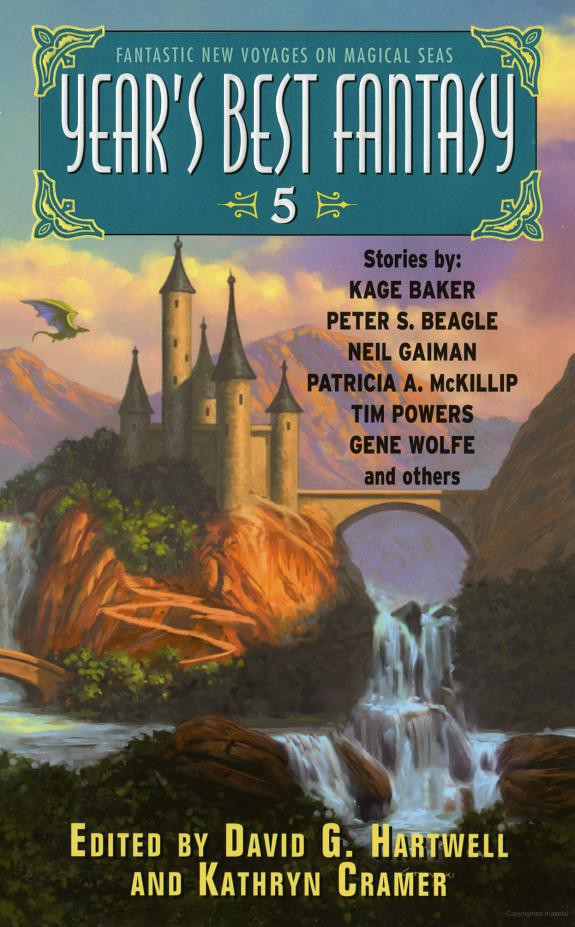
- The Dragons of Summer Gulch by Robert Reed
- Miss Emily Gray by Theodora Goss
- The Baum Plan for Financial Independence by John Kessel
- Lizzy Lou by Barbara Robson
- The End of the World as We Know It by Dale Bailey
- Leaving His Cares Behind Him by Kage Baker
- The Problem of Susan by Neil Gaiman
- Stella's Transformation by Kim Westwood
- Charlie the Purple Giraffe Was Acting Strangely by David D. Levine
- Pat Moore by Tim Powers
- Perpetua by Kit Reed
- Quarry by Peter S. Beagle
- Diva's Bones by John Meaney
- The Seventh Daughter by Bruce McAllister
- Life in Stone by Tim Pratt
- Many Voices by M. Rickert
- A Hint of Jasmine by Richard Parks
- Elvenbrood by Tanith Lee
- Beyond the River by Joel Lane
- Out of the Woods by Patricia A. McKillip
- The Man from Shemhaza by Steven Brust
- The Smile on the Face by Nalo Hopkinson
- Death's Door by Terry Bisson
- Golden City Far by Gene Wolfe
Publisher: Harper Voyager
